Paul van Yperen's Blog, page 291
November 5, 2017
Henry Stuart
Henry Stuart (1885-1942) was a British-Swiss actor, director and writer, who was very successful in the German silent cinema.
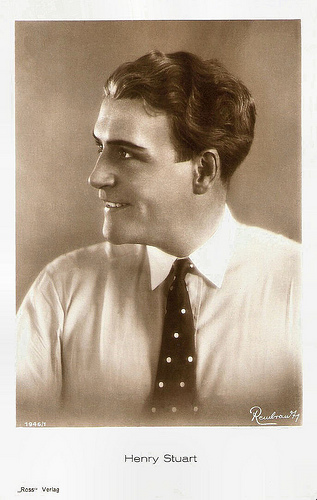
German postcard by Ross Verlag, no. 1946/1, 1927-1928. Photo: Rembrandt.
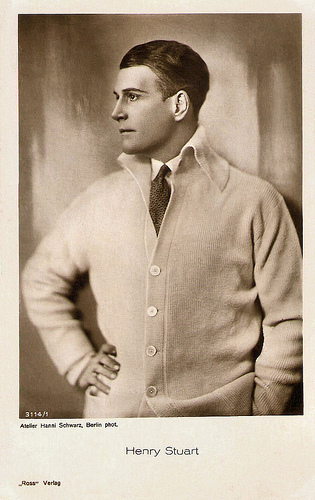
German postcard by Ross Verlag, no. 3114/1, 1928-1929. Photo: Atelier Hanni Schwarz, Berlin.
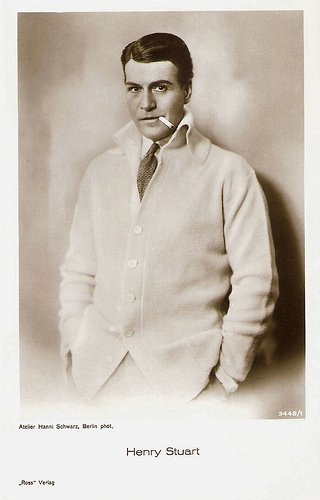
German postcard by Ross Verlag, no. 3448/1, 1928-1929. Photo: Atelier Hanni Schwarz.
Perfect Gentleman and Noble Lover
Henry Stuart was born as Henry Eduard Hess in Cairo, Egypt, in 1885. He was the son of a British colonial employee. Shortly before 1900 he returned to Britain but grew up mostly in Paris.
He visited the Akademie der Bildenden Künste München (Academy of Fine Arts in Munich), planning to become a painter. Shortly before World War One broke out, he was in Vienna, where he established his first contacts in the film world. During the war Stuart stayed in Britain, but afterwards he returned to Germany.
In 1922 he started his highly successful career as actor in the German silent cinema, often performing the perfect gentleman and noble lover. Probably his first appearance was a small part in the elaborate costume drama Ein Glas Wasser/A Glass of Water (Ludwig Berger, 1922) set in England during the reign of Queen Anne (Mady Christians). According to Wikipedia , the film was very well received both commercially and critically on its release. The film, based on a play of the same title by Eugène Scribe, is considered one of the milestones of Weimar cinema.
It was followed by the fantasy Die Perrücke/The Wig (Berthold Viertel, 1924) in which he played the major part of Julian, the lover of the Princess ( Jenny Hasselqvist ), whose husband ( Otto Gebühr ) tries to separate them.
In another classic Die freudlose Gasse/Joyless Street (G.W. Pabst, 1925), a morality tale set during the Viennese Depression, Stuart plays Egon Stirner, the secretary of an international speculator. He is arrested for the murder of a lawyer’s wife, but the culprit is the penniless Maria Lechner ( Asta Nielsen ). Maria is desperately in love with Stirner and has murdered the woman because she suspected her to be a rival. The film which also features Greta Garbo in one of her first roles, was one of the first films of the 'New Objectivity' movement.
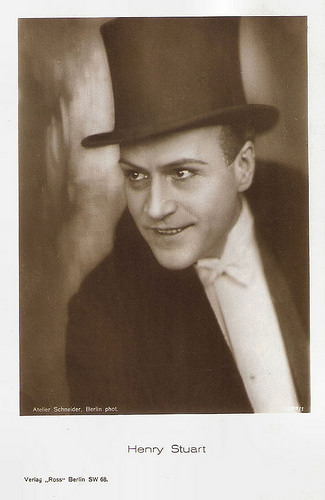
German postcard by Ross Verlag, Berlin, no. 1327/1, 1927-1928. Photo: Atelier Schneider, Berlin.
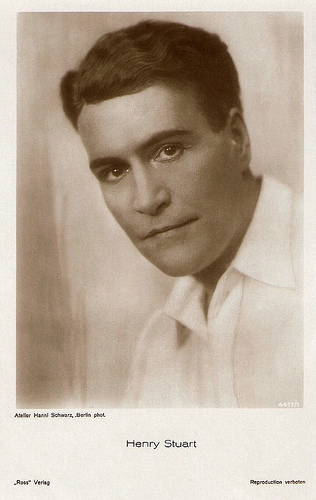
German postcard by Ross Verlag, no. 4417/1, 1929-1930. Photo: Atelier Hanni Schwarz, Berlin.
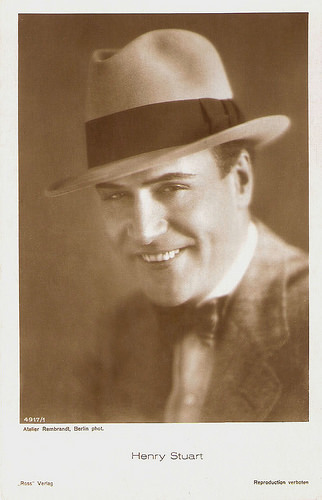
German postcard by Ross Verlag, no. 4917/1, 1929-1930. Photo: Atelier Rembrandt, Berlin.
India
In the following years Henry Suart starred in an impressive series of films. In 1925 he appeared in Die Strasse des Vergessens/The Street of Forgetting (Heinz Paul, 1925) with Hella Moja , and Das Abenteuer der Sybille Brant/The Adventures of Sybil Brent (Carl Froehlich, 1925) with Henny Porten.
The following year, he acted in such films as Unter Ausschluss der Öffentlichkeit/Under exclusion of the public (Conrad Wiene, 1926) with Maly Delschaft , Schenk mir das Leben/Give me the life (Klaus Fery, 1926), the war film Die versunkene Flotte/Wrath of the Seas (Graham Hewett, Manfred Noa, 1926) with Nils Asther , Die zwei und die Dame/The Two and the Lady (Alwin Neuss, 1926) with Agnes Esterhazy and Bernhard Goetzke , and Das Mädchen ohne Heimat/The Girl Without a Homeland (Constantin J. David, 1926).
In 1927 he appeared in Liebelei/Flirtation (Jakob & Luise Fleck, 1927) with Fred Louis Lerch and Evelyn Holt , Wenn Menschen reif zur Liebe werden/When people become ripe for love (Jakob & Luise Fleck, 1927), Die geheime Macht/Sajenko the Soviet (Erich Waschneck, 1927) with Walter Rilla , Die Frau mit dem Weltrekord/The Woman with the World Record (Erich Waschneck, 1927) with Lee Parry , and Der Bettler vom Kölner Dom/The beggar of the Cologne cathedral (Rolf Randolf, 1927) with Hanni Weisse .
He starred opposite Brigitte Helm in Der Skandal in Baden-Baden/The Scandal in Baden-Baden (Erich Waschneck, 1928). That same year, Stuart went to India to stage the feature film Der Ring der Bajadere, as well as direct the documentaries Der Maharadscha von Mysore hat Geburtstag/The Birthday of the Maharadja of Mysore (Henry Stuart, 1929) and Nuri, der Elefant/Nuri, the Elephant (Henry Stuart, 1930).
Back in Germany, Stuart played his last roles in silent films: the industrialist Erwin Voss in Das Recht auf Liebe/The right on love (Jakob & Luise Fleck, 1929), The film addresses the issue of the rights of ex-soldiers made impotent by war wounds to get married. It was made in the Weimar tradition of the Aufklärungsfilme (Enlightenment films).
He also played Kaiser Franz in the part-talkie Der Günstling von Schönbrunn/The Favourite of Schonbrunn (1929), starring Iván Petrovich and Lil Dagover . The historical film was directed by Erich Waschneck but Max Reichmann directed the sound sequences.
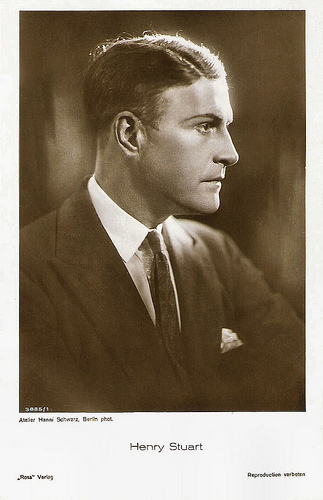
German postcard by Ross Verlag, no. 3885/1, 1928-1929. Photo: Atelier Hanni Schwarz, Berlin.
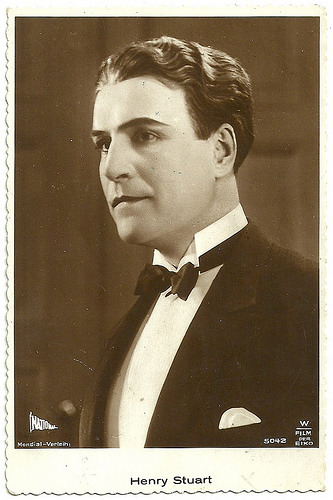
Austrian postcard, no. 5042. Photo: National / Mondial-Filmverleih / Eiko.
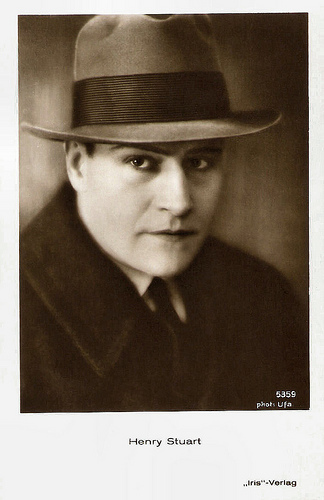
Austrian postcard by Iris Verlag, no. 5359. Photo: Ufa.
All-Star Super-Production
In the sound era, Henry Stuart didn’t find much work. In Berlin, he performed at the Englischen Theater Deutscher Schauspieler and worked for the radio as well as a manuscript and title translator. In 1933 he directed a short, Zwischen 12 und 2/Between 12 and 2, based on the play Hotelratten/Hotel rats.
In 1938 he co-wrote the script for the Yiddish-American production The Power of Life. He became Swiss citizen and in 1941 he released the only feature sound film directed by him: Krishna. Abenteuer im indischen Dschungel/Krishna, adventures in the Indian Jungle (1941), codirected and conscripted with Lola Kreuzberg, whose company had already produced Stuart’s films in India in 1928-1929. It probably was a sound version of Der Ring der Bajadere.
In 1942, Stuart played a British enemy in the propaganda film Germanin (Max W. Kimmich, 1942) starring famous Austrian mountain climber Luis Trenker as a German doctor in Africa who discovers and proves the efficacy of a cure for sleeping sickness - a serum called `Germanin'.
The film has strong anti-British undertones and the history of the film is horrendous. In the summer of 1940, 4,000 black POWs were transferred to Stalag IIIA, a Luckenwalde Germany Prisoner of War camp. Three hundred of these men, including African-Americans and French speaking Africans were forced to participate as extras in this Nazi film. Many of them were later exterminated by the Nazis.
His final film appearance was a small uncredited part, again as a British lord, in the all-star super-production Münchhausen/Baron Munchhausen (Josef von Baky, 1943) featuring Hans Albers . The Agfa colour epic was released after Stuart's death.
How, when and where exactly Henry Stuart died is unclear. His death year is indicated by several sources ( IMDb, Cyranos, Filmportal.de ) as 1942, but according to German Wikipedia it was after 1942. Another question is: did the Nazis force Stuart to appear in Germanin, like they had forced British silent film actor Jack Trevor to act in other anti-British propaganda films?
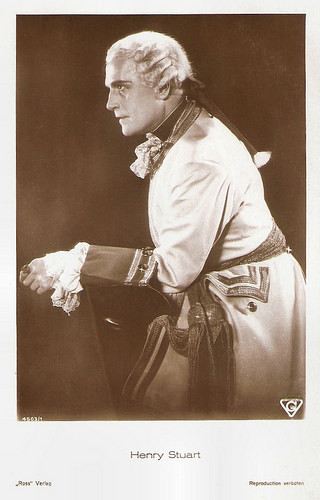
German postcard by Ross Verlag, no. 4503/1, 1929-1930. Photo: Photo: G [Greenbaum-Film]. Publicity still for Der Günstling von Schönbrunn/Favorite of Schonbrunn (Erich Waschneck, Max Reichmann, 1929).
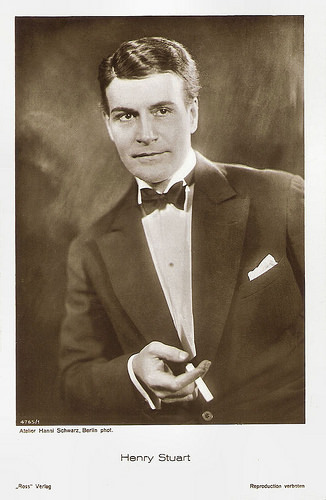
German postcard by Ross Verlag, no. 4765/1, 1929-1930. Photo: Photo: Atelier Hanni Schwarz, Berlin.
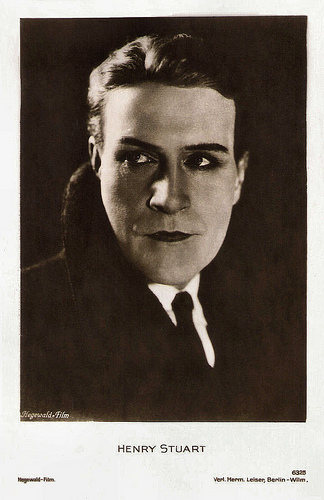
German postcard by Verlag Herm. Leiser, Berlin-Wilm., no. 6325. Photo: Hegewald-Film.
Sources: Filmportal.de, Thomas Staedeli (Cyranos), Wikipedia (English and German) and .

German postcard by Ross Verlag, no. 1946/1, 1927-1928. Photo: Rembrandt.

German postcard by Ross Verlag, no. 3114/1, 1928-1929. Photo: Atelier Hanni Schwarz, Berlin.

German postcard by Ross Verlag, no. 3448/1, 1928-1929. Photo: Atelier Hanni Schwarz.
Perfect Gentleman and Noble Lover
Henry Stuart was born as Henry Eduard Hess in Cairo, Egypt, in 1885. He was the son of a British colonial employee. Shortly before 1900 he returned to Britain but grew up mostly in Paris.
He visited the Akademie der Bildenden Künste München (Academy of Fine Arts in Munich), planning to become a painter. Shortly before World War One broke out, he was in Vienna, where he established his first contacts in the film world. During the war Stuart stayed in Britain, but afterwards he returned to Germany.
In 1922 he started his highly successful career as actor in the German silent cinema, often performing the perfect gentleman and noble lover. Probably his first appearance was a small part in the elaborate costume drama Ein Glas Wasser/A Glass of Water (Ludwig Berger, 1922) set in England during the reign of Queen Anne (Mady Christians). According to Wikipedia , the film was very well received both commercially and critically on its release. The film, based on a play of the same title by Eugène Scribe, is considered one of the milestones of Weimar cinema.
It was followed by the fantasy Die Perrücke/The Wig (Berthold Viertel, 1924) in which he played the major part of Julian, the lover of the Princess ( Jenny Hasselqvist ), whose husband ( Otto Gebühr ) tries to separate them.
In another classic Die freudlose Gasse/Joyless Street (G.W. Pabst, 1925), a morality tale set during the Viennese Depression, Stuart plays Egon Stirner, the secretary of an international speculator. He is arrested for the murder of a lawyer’s wife, but the culprit is the penniless Maria Lechner ( Asta Nielsen ). Maria is desperately in love with Stirner and has murdered the woman because she suspected her to be a rival. The film which also features Greta Garbo in one of her first roles, was one of the first films of the 'New Objectivity' movement.

German postcard by Ross Verlag, Berlin, no. 1327/1, 1927-1928. Photo: Atelier Schneider, Berlin.

German postcard by Ross Verlag, no. 4417/1, 1929-1930. Photo: Atelier Hanni Schwarz, Berlin.

German postcard by Ross Verlag, no. 4917/1, 1929-1930. Photo: Atelier Rembrandt, Berlin.
India
In the following years Henry Suart starred in an impressive series of films. In 1925 he appeared in Die Strasse des Vergessens/The Street of Forgetting (Heinz Paul, 1925) with Hella Moja , and Das Abenteuer der Sybille Brant/The Adventures of Sybil Brent (Carl Froehlich, 1925) with Henny Porten.
The following year, he acted in such films as Unter Ausschluss der Öffentlichkeit/Under exclusion of the public (Conrad Wiene, 1926) with Maly Delschaft , Schenk mir das Leben/Give me the life (Klaus Fery, 1926), the war film Die versunkene Flotte/Wrath of the Seas (Graham Hewett, Manfred Noa, 1926) with Nils Asther , Die zwei und die Dame/The Two and the Lady (Alwin Neuss, 1926) with Agnes Esterhazy and Bernhard Goetzke , and Das Mädchen ohne Heimat/The Girl Without a Homeland (Constantin J. David, 1926).
In 1927 he appeared in Liebelei/Flirtation (Jakob & Luise Fleck, 1927) with Fred Louis Lerch and Evelyn Holt , Wenn Menschen reif zur Liebe werden/When people become ripe for love (Jakob & Luise Fleck, 1927), Die geheime Macht/Sajenko the Soviet (Erich Waschneck, 1927) with Walter Rilla , Die Frau mit dem Weltrekord/The Woman with the World Record (Erich Waschneck, 1927) with Lee Parry , and Der Bettler vom Kölner Dom/The beggar of the Cologne cathedral (Rolf Randolf, 1927) with Hanni Weisse .
He starred opposite Brigitte Helm in Der Skandal in Baden-Baden/The Scandal in Baden-Baden (Erich Waschneck, 1928). That same year, Stuart went to India to stage the feature film Der Ring der Bajadere, as well as direct the documentaries Der Maharadscha von Mysore hat Geburtstag/The Birthday of the Maharadja of Mysore (Henry Stuart, 1929) and Nuri, der Elefant/Nuri, the Elephant (Henry Stuart, 1930).
Back in Germany, Stuart played his last roles in silent films: the industrialist Erwin Voss in Das Recht auf Liebe/The right on love (Jakob & Luise Fleck, 1929), The film addresses the issue of the rights of ex-soldiers made impotent by war wounds to get married. It was made in the Weimar tradition of the Aufklärungsfilme (Enlightenment films).
He also played Kaiser Franz in the part-talkie Der Günstling von Schönbrunn/The Favourite of Schonbrunn (1929), starring Iván Petrovich and Lil Dagover . The historical film was directed by Erich Waschneck but Max Reichmann directed the sound sequences.

German postcard by Ross Verlag, no. 3885/1, 1928-1929. Photo: Atelier Hanni Schwarz, Berlin.

Austrian postcard, no. 5042. Photo: National / Mondial-Filmverleih / Eiko.

Austrian postcard by Iris Verlag, no. 5359. Photo: Ufa.
All-Star Super-Production
In the sound era, Henry Stuart didn’t find much work. In Berlin, he performed at the Englischen Theater Deutscher Schauspieler and worked for the radio as well as a manuscript and title translator. In 1933 he directed a short, Zwischen 12 und 2/Between 12 and 2, based on the play Hotelratten/Hotel rats.
In 1938 he co-wrote the script for the Yiddish-American production The Power of Life. He became Swiss citizen and in 1941 he released the only feature sound film directed by him: Krishna. Abenteuer im indischen Dschungel/Krishna, adventures in the Indian Jungle (1941), codirected and conscripted with Lola Kreuzberg, whose company had already produced Stuart’s films in India in 1928-1929. It probably was a sound version of Der Ring der Bajadere.
In 1942, Stuart played a British enemy in the propaganda film Germanin (Max W. Kimmich, 1942) starring famous Austrian mountain climber Luis Trenker as a German doctor in Africa who discovers and proves the efficacy of a cure for sleeping sickness - a serum called `Germanin'.
The film has strong anti-British undertones and the history of the film is horrendous. In the summer of 1940, 4,000 black POWs were transferred to Stalag IIIA, a Luckenwalde Germany Prisoner of War camp. Three hundred of these men, including African-Americans and French speaking Africans were forced to participate as extras in this Nazi film. Many of them were later exterminated by the Nazis.
His final film appearance was a small uncredited part, again as a British lord, in the all-star super-production Münchhausen/Baron Munchhausen (Josef von Baky, 1943) featuring Hans Albers . The Agfa colour epic was released after Stuart's death.
How, when and where exactly Henry Stuart died is unclear. His death year is indicated by several sources ( IMDb, Cyranos, Filmportal.de ) as 1942, but according to German Wikipedia it was after 1942. Another question is: did the Nazis force Stuart to appear in Germanin, like they had forced British silent film actor Jack Trevor to act in other anti-British propaganda films?

German postcard by Ross Verlag, no. 4503/1, 1929-1930. Photo: Photo: G [Greenbaum-Film]. Publicity still for Der Günstling von Schönbrunn/Favorite of Schonbrunn (Erich Waschneck, Max Reichmann, 1929).

German postcard by Ross Verlag, no. 4765/1, 1929-1930. Photo: Photo: Atelier Hanni Schwarz, Berlin.

German postcard by Verlag Herm. Leiser, Berlin-Wilm., no. 6325. Photo: Hegewald-Film.
Sources: Filmportal.de, Thomas Staedeli (Cyranos), Wikipedia (English and German) and .
Published on November 05, 2017 22:00
November 4, 2017
Romuald Joubé
Today, EYE Filmmuseum in Amsterdam presents the French silent film La Chèvre aux pieds d'or/The Goat with the Golden Feet (Jacques Robert, 1925), vaguely inspired by the biography of Mata Hari. The film is shown within the framework of the new exhibition Mata Hari - The Myth and the Maiden at Fries Museum in Leeuwarden, and introduced by film historian and EFSP co-editor Ivo Blom, who collaborated on the exhibition. Male lead of the film is Romuald Joubé (1876-1949). He was a French silent film actor, who became famous for his part in Abel Gance’s J’accuse (1918). He also acted in various naturalistic features by André Antoine.
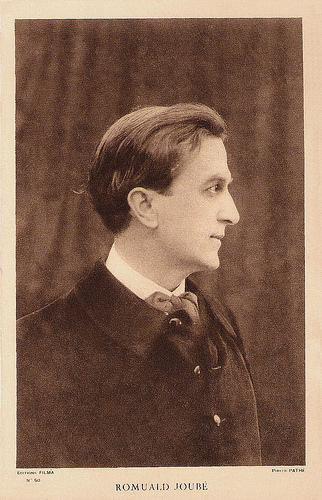
French postcard by Editions Filma, no. 50. Photo: Pathé.
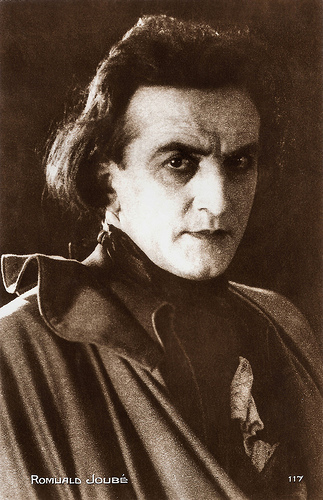
French postcard by Editions Cinémagazine, no. 117.
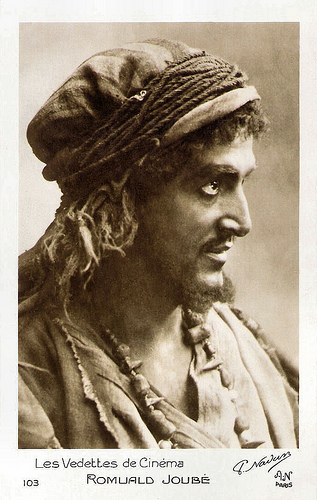
French postcard in the series Les Vedettes de Cinéma by A.N., Paris, no 103. Photo: P. Nadar.
The Horrors of the War
Romuald Joubé, originally Romuald Charles Eugène Goudens Jean Sylve Joubé was born in Mazères, France in 1876.
Around 1900, Joubé already acted on stage with the troupe of the Nouveau-Théàtre of Paris, directed by Lugné-Poë. Around 1909 he started at the Théàtre de l’Odéon with plays directed by André Antoine, the master of Naturalism in French theatre.
In 1910 he debuted in the cinema in the Film d’art productions. He played in various shorts, often directed by Henri Desfontaines. These included Polyeucte (Camille de Morlhon, 1910), Philémon et Baucis (Georges Denola, 1911) as Philemon, Milton (Henri Desfontaines, 1911) with Constant Rémy, La Mégère apprivoisée/The Taming Of The Shrew (Henri Desfontaines, 1911). He played the title roles in Le Colonel Chabert (Henri Pouctal, André Calmettes, 1911) and Brittanicus (Camille de Morlhon, 1912)
Other Film d'art films were Serge Panine (Henri Pouctal, 1913), Le Baiser supreme/The Kiss supreme (Edmond Floury, 1913) opposite Gabriel Signoret , Les Deux gosses/The Two Kids (Albert Capellani, 1914) with Paul Capellani , Amour sacré/Holy Love (Dominique Bernard-Deschamps, 1915), and Le Dernier rêve/The Last Dream (Henri Desfontaines, 1916).
In 1917, Joubé started to act in various features by André Antoine, who transferred his Naturalism onto cinema as well: the Alexandre Dumas père adaptation Les Frères corses/The Corsican Brothers (André Antoine, 1917) with Henry Krauss , the François Coppée adaptation Le Coupable/The Culprit (André Antoine, 1917) with Sylvie , and the fishermen drama Les Travailleurs de la mer/The Workers of the sea (André Antoine, 1918), based on Victor Hugo.
By now Joubé was playing both leading and supporting parts. In 1918-1919, Joubé played one of his most famous roles in the pacifist, First World War drama J’Accuse/I Accuse by Abel Gance , which was released in France in April 1919, so a few months after the Armistice.
Joubé plays Jean Diaz, a poet who is in love with Edith (Marise Dauvray), the wife of François Laurin ( Séverin-Mars ). The two men meet in the trenches and experience the horrors of the war. Laurin saves Diaz’ life and sacrifices himself for the benefit of the other two. Edith is raped by a German, raising the fruit of this encounter despite hostility. Maddened, Diaz returns from the trenches, despises his art and asks the village inhabitants: was it worthwhile, all the sacrifices, while the ghosts of the killed soldiers march up to them.
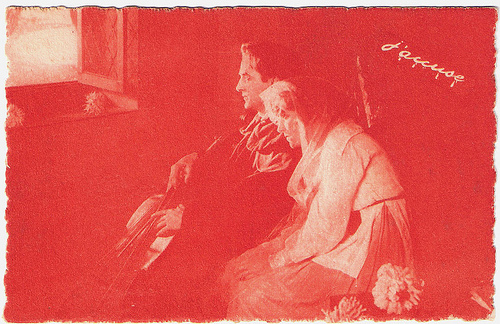
French postcard by Sadag de France, Paris, no. 109. Publicity still for J'Accuse (Abel Gance, 1919) with Edith (Marise Dauvray), Jean Diaz (Romuald Joubé).
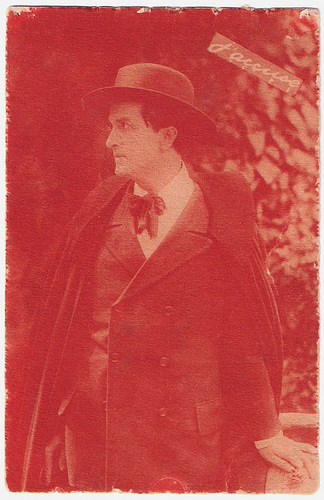
French postcard by Sadag de France, Paris. Publicity still for J'Accuse (Abel Gance, 1919).
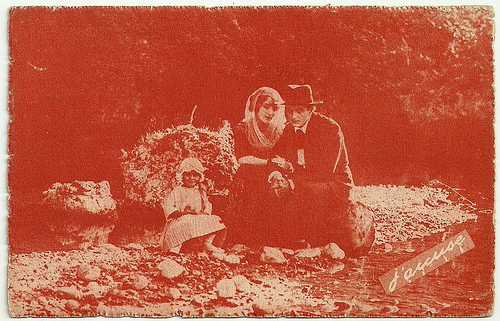
French postcard by Sadag de France, Paris, no. 109. Publicity still for J'Accuse (Abel Gance, 1919) with Edith (Marise Dauvray), Jean Diaz (Romuald Joubé) and little Angele (Angèle Guys), towards the end of the film.
Lavish Period Piece
With J’Accuse, Romuald Joubé established his career, though he didn’t continue to act with Gance. Instead he performed opposite Emmy Lynn in La faute d’Odette Marchal/Odette Marchal's fault (Henri Roussel, 1920), opposite Huguette Duflos in Mademoiselle de La Seiglière (André Antoine, 1921), opposite Sylviane Dumont in Fleur de neige/Snow Flower (Paul Barlatier, 1921) and he played the title role in the Jules Verne adaptation Mathias Sandorf (Henri Fescourt, 1921).
Subsequently he appeared opposite Pierre Fresnay in Le Diamant noir/The Black Diamond (André Hugon, 1922) and opposite Nathalie Lissenko in La Fille sauvage (Henri Étievant, 1922).
From 1923 Joubé alternated film with the stage. In the theatre he played e.g. the title role in Peer Gynt in 1924. Still he had big film roles as Andréa in Rouletabille chez les bohémiens/Rouletabille and the Bohemians (Henri Fescourt, 1923) with Gabriel de Gravone , as the title character in the historical adventure film Mandrin (Henri Fescourt, 1924) costarring Jacqueline Blanc , and as chevalier Robert Cottereau in the lavish period piece Le Miracle des loups/Miracle of the Wolves (Raymond Bernard, 1924).
In 1925 Joubé not only acted opposite Lilian Constantini in La Chèvre aux pieds d'or/The Goat with the golden feet (Jacques Robert, 1925), but he also went to Italy to act in several historical films by Giulio Antamoro: La Fanciulla di Pompei/The young girl of Pompeii (Giulio Antamoro, 1925) with Leda Gys, La Cieca di Sorrento/The Blind Girl of Sorrento (Giulio Antamoro, 1925) and Frate Francesco/The Passion of St. Francis (Giulio Antamoro, 1927).
Probably Joubé’s last silent film was the Henri Kistemaeckers adaptation Princesse Masha/Princess Masha (1927, René Leprince). The film is about an illegitimate Russian princess, raised by revolutionary intellectuals, who flees to Paris during the revolution and falls in love with a Frenchman (Joubé), but marries a cruel Russian ambassador to save her foster father (in vain). Returned to Russia during the war, she tries to flee again, with her French lover, and sacrifices herself in the end for his honour. The film starred Claudia Victrix, a French singer who debuted in this film. Costars were Jean Toulout and Andrée Brabant.
When sound cinema became the standard in France, Joubé didn’t act in films for years, though he was visible in a sonorised version of Le Miracle des loups (1930). In 1929 he acted in various stage plays in Canada, together with Germaine Rouer . In the same year he also acted in Histoires de France, the play by Sacha Guitry that opened the new Théàtre Pigalle in Paris in 1929.
In 1937 he returned to the film set with a small part as Jean Diaz in Abel Gance ’s own remake of J’accuse (Abel Gance, 1938), while the larger share of the character was played by Victor Francen. That year he also played Clouet in Sacha Guitry ’s period piece Les Perles de la couronne (Sacha Guitry, 1937).
Joubé played his last roles in film and on stage during the Second World War. On stage he played in the Georges Simenon adaptation Le Pavillon d'Asnières (1943), while on the set he performed in a.o. Chant de l'exilé/Song of Exile (André Hugo, 1943) starring Tino Rossi .
Romuald Joubé died in 1949 in Gisors, France.
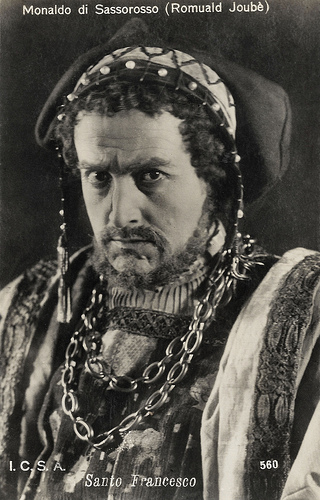
Italian postcard by ICSA, no. 560. Photo: publicity still for Frate Francesco (Giulio Antamoro, 1927) with Romuald Joubé as Monaldo di Sassorosso.
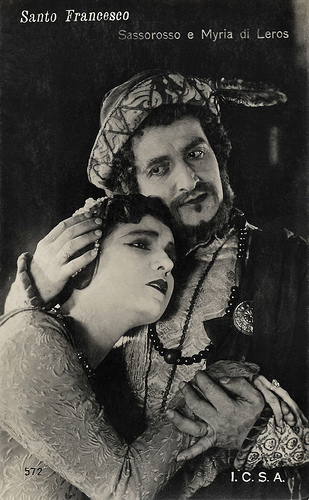
Italian postcard by ICSA, no. 572. Photo: publicity still for Frate Francesco (Giulio Antamoro, 1927) with Monaldo di Sassorosso (Romuald Joubé) and Myria di Leros (Donatella Gemmò).
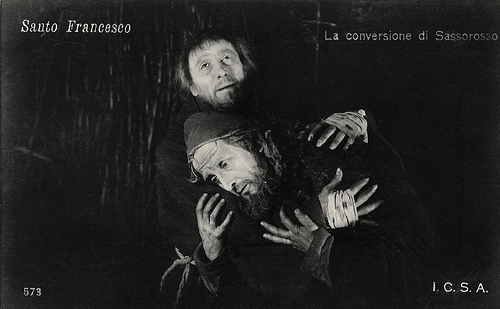
Italian postcard by ICSA, no. 573. Photo: publicity still for Frate Francesco (Giulio Antamoro, 1927). Caption: 'The conversion of Sassorosso.' Visible are Alberto Pasquali as St. Francis and Romuald Joubé as Sassorosso.
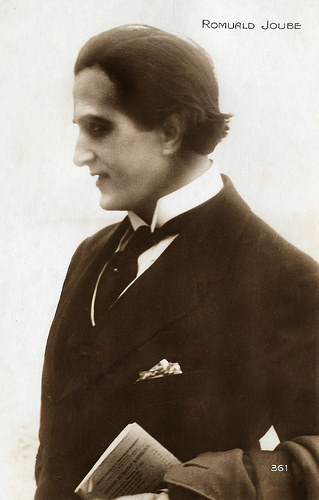
French postcard by Cinémagazine-Edition, Paris, no. 361.
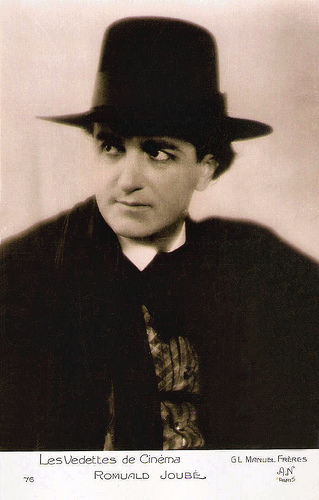
French postcard in the series Les Vedettes de Cinéma by A.N., Paris, no 76. Photo: G.L. Manuel Frères.
Sources: CinéRessources, Films de France, Wikipedia (French) and .

French postcard by Editions Filma, no. 50. Photo: Pathé.

French postcard by Editions Cinémagazine, no. 117.

French postcard in the series Les Vedettes de Cinéma by A.N., Paris, no 103. Photo: P. Nadar.
The Horrors of the War
Romuald Joubé, originally Romuald Charles Eugène Goudens Jean Sylve Joubé was born in Mazères, France in 1876.
Around 1900, Joubé already acted on stage with the troupe of the Nouveau-Théàtre of Paris, directed by Lugné-Poë. Around 1909 he started at the Théàtre de l’Odéon with plays directed by André Antoine, the master of Naturalism in French theatre.
In 1910 he debuted in the cinema in the Film d’art productions. He played in various shorts, often directed by Henri Desfontaines. These included Polyeucte (Camille de Morlhon, 1910), Philémon et Baucis (Georges Denola, 1911) as Philemon, Milton (Henri Desfontaines, 1911) with Constant Rémy, La Mégère apprivoisée/The Taming Of The Shrew (Henri Desfontaines, 1911). He played the title roles in Le Colonel Chabert (Henri Pouctal, André Calmettes, 1911) and Brittanicus (Camille de Morlhon, 1912)
Other Film d'art films were Serge Panine (Henri Pouctal, 1913), Le Baiser supreme/The Kiss supreme (Edmond Floury, 1913) opposite Gabriel Signoret , Les Deux gosses/The Two Kids (Albert Capellani, 1914) with Paul Capellani , Amour sacré/Holy Love (Dominique Bernard-Deschamps, 1915), and Le Dernier rêve/The Last Dream (Henri Desfontaines, 1916).
In 1917, Joubé started to act in various features by André Antoine, who transferred his Naturalism onto cinema as well: the Alexandre Dumas père adaptation Les Frères corses/The Corsican Brothers (André Antoine, 1917) with Henry Krauss , the François Coppée adaptation Le Coupable/The Culprit (André Antoine, 1917) with Sylvie , and the fishermen drama Les Travailleurs de la mer/The Workers of the sea (André Antoine, 1918), based on Victor Hugo.
By now Joubé was playing both leading and supporting parts. In 1918-1919, Joubé played one of his most famous roles in the pacifist, First World War drama J’Accuse/I Accuse by Abel Gance , which was released in France in April 1919, so a few months after the Armistice.
Joubé plays Jean Diaz, a poet who is in love with Edith (Marise Dauvray), the wife of François Laurin ( Séverin-Mars ). The two men meet in the trenches and experience the horrors of the war. Laurin saves Diaz’ life and sacrifices himself for the benefit of the other two. Edith is raped by a German, raising the fruit of this encounter despite hostility. Maddened, Diaz returns from the trenches, despises his art and asks the village inhabitants: was it worthwhile, all the sacrifices, while the ghosts of the killed soldiers march up to them.

French postcard by Sadag de France, Paris, no. 109. Publicity still for J'Accuse (Abel Gance, 1919) with Edith (Marise Dauvray), Jean Diaz (Romuald Joubé).

French postcard by Sadag de France, Paris. Publicity still for J'Accuse (Abel Gance, 1919).

French postcard by Sadag de France, Paris, no. 109. Publicity still for J'Accuse (Abel Gance, 1919) with Edith (Marise Dauvray), Jean Diaz (Romuald Joubé) and little Angele (Angèle Guys), towards the end of the film.
Lavish Period Piece
With J’Accuse, Romuald Joubé established his career, though he didn’t continue to act with Gance. Instead he performed opposite Emmy Lynn in La faute d’Odette Marchal/Odette Marchal's fault (Henri Roussel, 1920), opposite Huguette Duflos in Mademoiselle de La Seiglière (André Antoine, 1921), opposite Sylviane Dumont in Fleur de neige/Snow Flower (Paul Barlatier, 1921) and he played the title role in the Jules Verne adaptation Mathias Sandorf (Henri Fescourt, 1921).
Subsequently he appeared opposite Pierre Fresnay in Le Diamant noir/The Black Diamond (André Hugon, 1922) and opposite Nathalie Lissenko in La Fille sauvage (Henri Étievant, 1922).
From 1923 Joubé alternated film with the stage. In the theatre he played e.g. the title role in Peer Gynt in 1924. Still he had big film roles as Andréa in Rouletabille chez les bohémiens/Rouletabille and the Bohemians (Henri Fescourt, 1923) with Gabriel de Gravone , as the title character in the historical adventure film Mandrin (Henri Fescourt, 1924) costarring Jacqueline Blanc , and as chevalier Robert Cottereau in the lavish period piece Le Miracle des loups/Miracle of the Wolves (Raymond Bernard, 1924).
In 1925 Joubé not only acted opposite Lilian Constantini in La Chèvre aux pieds d'or/The Goat with the golden feet (Jacques Robert, 1925), but he also went to Italy to act in several historical films by Giulio Antamoro: La Fanciulla di Pompei/The young girl of Pompeii (Giulio Antamoro, 1925) with Leda Gys, La Cieca di Sorrento/The Blind Girl of Sorrento (Giulio Antamoro, 1925) and Frate Francesco/The Passion of St. Francis (Giulio Antamoro, 1927).
Probably Joubé’s last silent film was the Henri Kistemaeckers adaptation Princesse Masha/Princess Masha (1927, René Leprince). The film is about an illegitimate Russian princess, raised by revolutionary intellectuals, who flees to Paris during the revolution and falls in love with a Frenchman (Joubé), but marries a cruel Russian ambassador to save her foster father (in vain). Returned to Russia during the war, she tries to flee again, with her French lover, and sacrifices herself in the end for his honour. The film starred Claudia Victrix, a French singer who debuted in this film. Costars were Jean Toulout and Andrée Brabant.
When sound cinema became the standard in France, Joubé didn’t act in films for years, though he was visible in a sonorised version of Le Miracle des loups (1930). In 1929 he acted in various stage plays in Canada, together with Germaine Rouer . In the same year he also acted in Histoires de France, the play by Sacha Guitry that opened the new Théàtre Pigalle in Paris in 1929.
In 1937 he returned to the film set with a small part as Jean Diaz in Abel Gance ’s own remake of J’accuse (Abel Gance, 1938), while the larger share of the character was played by Victor Francen. That year he also played Clouet in Sacha Guitry ’s period piece Les Perles de la couronne (Sacha Guitry, 1937).
Joubé played his last roles in film and on stage during the Second World War. On stage he played in the Georges Simenon adaptation Le Pavillon d'Asnières (1943), while on the set he performed in a.o. Chant de l'exilé/Song of Exile (André Hugo, 1943) starring Tino Rossi .
Romuald Joubé died in 1949 in Gisors, France.

Italian postcard by ICSA, no. 560. Photo: publicity still for Frate Francesco (Giulio Antamoro, 1927) with Romuald Joubé as Monaldo di Sassorosso.

Italian postcard by ICSA, no. 572. Photo: publicity still for Frate Francesco (Giulio Antamoro, 1927) with Monaldo di Sassorosso (Romuald Joubé) and Myria di Leros (Donatella Gemmò).

Italian postcard by ICSA, no. 573. Photo: publicity still for Frate Francesco (Giulio Antamoro, 1927). Caption: 'The conversion of Sassorosso.' Visible are Alberto Pasquali as St. Francis and Romuald Joubé as Sassorosso.

French postcard by Cinémagazine-Edition, Paris, no. 361.

French postcard in the series Les Vedettes de Cinéma by A.N., Paris, no 76. Photo: G.L. Manuel Frères.
Sources: CinéRessources, Films de France, Wikipedia (French) and .
Published on November 04, 2017 23:00
November 3, 2017
Edition Pathé Frères (1)
The last three Saturdays, EFSP had posts on French postcard series like Les Vedettes du Cinéma. Today, we present you cartes postales by Edition Pathé Frères. Four brothers, Charles, Émile, Théophile and Jacques Pathé, founded the Société Pathé Frères (Pathé Brothers Company) in Paris on 28 September 1896. Between 1903 and 1910, Pathé dominated the international film world. Three-quarter of what every film visitor, even in America, would see in a vaudeville house, in the booth of a travelling cinema, or in one of the very early permanent cinemas, were Pathé productions. The driving force behind this pioneering film operation was Charles Pathé. He set both the artistic and technical standards for film. Pathé Frères also pioneered with postcards of the actors in his films. Today we present you an early series by Edition Pathé Frères of black and white postcards, made just before the First World War.
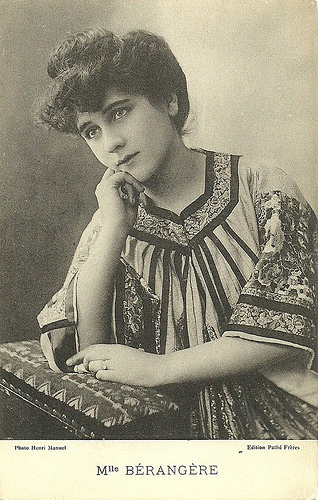
Jeanne Bérangère. French postcard by Edition Pathé Frères. Photo: Henri Manuel. A difficulty with this card, which is easily found online as well, is that it dates from around 1910-1914. French stage and screen actress Jeanne Bérangère (1864-1927) was born in 1864, so in 1914 she must have been around 50. And the woman on the postcard seems much younger. We could not trace whether Pathé used a pre-1900 photo, a photo of a relative with the same name (a daughter?), or just a photo of somebody else.
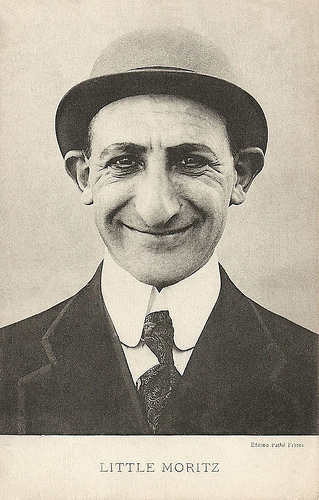
Little Moritz. French postcard by Edition Pathé Frères.
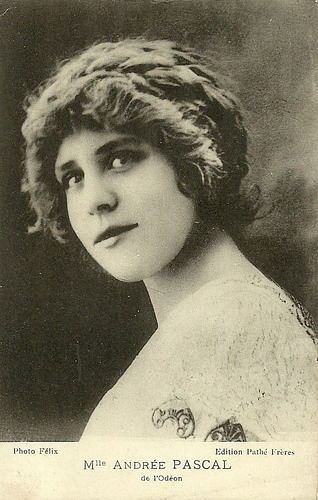
Andrée Pascal. French postcard by Edition Pathé Frères. Photo: Félix.
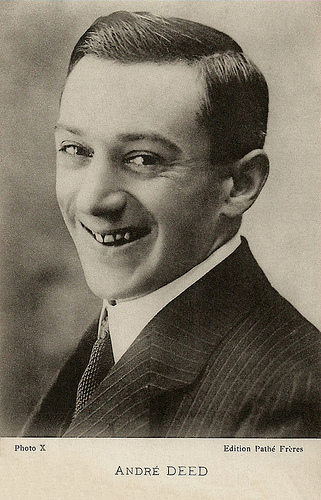
André Deed . French postcard by Edition Pathé Frères. Photo: X.
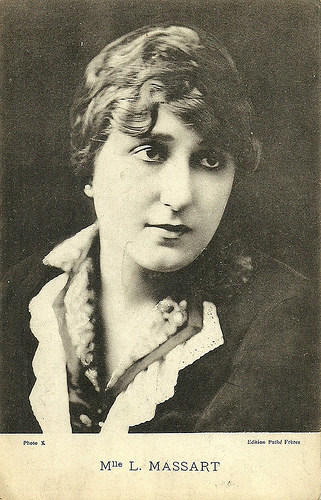
Léontine Massart . French postcard by Edition Pathé Frères. Photo: X.
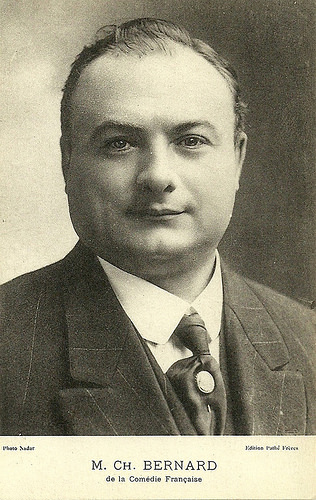
Léon Bernard . French postcard by Edition Pathé Frères. Photo: Nadar. The Ch. must be a mistake, as this is clearly French stage and screen actor and also theatre director Léon Bernard .
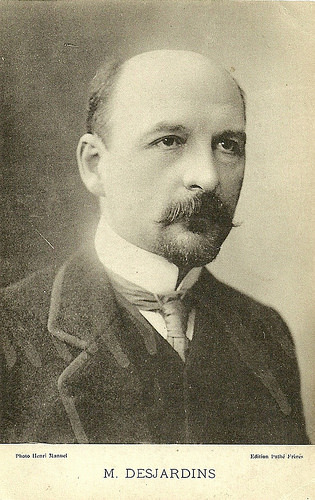
Maxime Desjardins . French postcard by Edition Pathé Frères. Photo: Henri Manuel.
One of the first feature-length films about Jesus
In 1896, Pathé Frères began using the camera developed by the Lumière brothers and then Pathé set about to design an improved studio camera and to make their own film stock. From 1901, Pathé teamed up with director and later manager Ferdinand Zecca who oversaw the creation and production of original Pathé Frères films.
Pathé opened sales agencies all over the world, selling projectors, films and equipment. In 1902 it opened a glass house studio near Paris, in 1904 two other ones. At Joinville-le-Pont, also near Paris, a series of factories were built to produce cameras and projectors and to develop film stock, with a separate section for colouring films.
From 1905 on, the company employed a specialised studio staff: screenwriters, directors, cinematographers and other technicians. In 1905 Pathé produced some 12.000 meters film stock per month of positive film, by now mostly fiction films. Zecca explored many themes from the mundane to the fantastic. In À la conquête de l'air/Conquering the Skies (Ferdinand Zecca, 1901), a strange flying machine, called Fend-l'air, was seen flying over the rooftops of Belleville. By using trick photography, the one-minute short was notable in being the first aviation film, predating the flight by the Wright Brothers by two years.
Zecca also pioneered with one of the first crime dramas, Histoire d'un crime/History of a Crime (Ferdinand Zecca, 1901), stylistically innovative in its use of superimposition. The story was of a man condemned to death, awaiting execution with his crimes appearing on his cell wall. The film is an early example of flashbacks as a film device. Other Pathé films included comedies, trick films or fairy tales, such as Les Sept châteaux du Diable/The Seven Castles of the Devil (Ferdinand Zecca, 1901), and La Belle au bois dormant/Sleeping Beauty (1902).
Pathé also produced social dramas like Les Victimes de l'alcoolisme/Alcohol and Its Victims (Ferdinand Zecca, 1902), Au pays noir/Down in the Coal Mines (Lucien Nonguet, Ferdinand Zecca, 1905) and reconstructions of actual events, the most famous being La Catastrophe de la Martinique/Martinique Disaster (Ferdinand Zecca, 1902). Zecca also acted in many of his films.
Between 1900 and 1907, Zecca oversaw the production of hundreds of Pathé films from many important Pathé directors including Lucien Nonguet, Gaston Velle, Albert Capellani, Louis J. Gasnier, André Heuzé and Henri Pouctal. Zecca also acted, directed, produced, and, on occasion, wrote films. These films were at most 300 meters in length, so max. 15 minutes of screening time (which is already quite longer than the single take films of Lumière, and consisted of various shots edited together).
La Vie et la passion de Jésus Christ/Life and Passion of the Christ (Lucien Nonguet, Ferdinand Zecca, 1903) was, at a running time of 44 minutes, one of the first feature-length films about Jesus. Production grew massively: in 1906 the output of positive film stock tripled that of the year before. In 1906, Spaniard Segundo de Chomón arrived at the Pathé studio and assisted Zecca with photography and special effects. He started to colour films, such as Vie et Passion de N.S. Jésus Christ/Life and Passion of Christ (Ferdinand Zecca, 1907), shot in four parts with 38 scenes, 990 metres long. At first, the films were hand-coloured, and later semi-mechanically coloured with stencils, a method also used for colouring postcards.
After Pathé bought the rights to George Méliès's Star films, Zecca started editing the Méliès films. Film production went from 70 titles in 1901 to 500 in 1903. After 1906, the mass film production gradually eased as longer films were produced. Pathé and Méliès started to work together in 1911. Georges Méliès's first film to be distributed by Pathé was the fantasy-comedy Les aventures de baron de Munchhausen/Baron Munchausen's Dream (Georges Méliès, 1911).
Pathé Frères filmed numerous short subjects, the majority of which are sensational criminal adventures, melodramatic love stories, and comedies. In 1912 Pathé produced its first feature film, Les Misérables (Albert Capellani, 1912), a four-reel screen version of the novel by Victor Hugo starring Henry Krauss as Jean Valjean and Maria Fromet as Cosette. In 1912, Pathé appointed Alfred Machin to develop the first studio films at Sint-Jans-Molenbeek, Château Karreveld, Belgium. And in 1914, Pathé Frères studios in the United States released the first episodes of The Perils of Pauline (Louis J. Gasnier, Donald MacKenzie, 1914) featuring Pearl White, one of the earliest and best remembered screen serials.
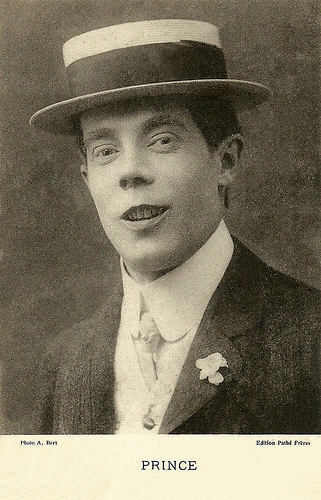
Charles Prince . French postcard by Edition Pathé Frères. Photo: A. Bert.
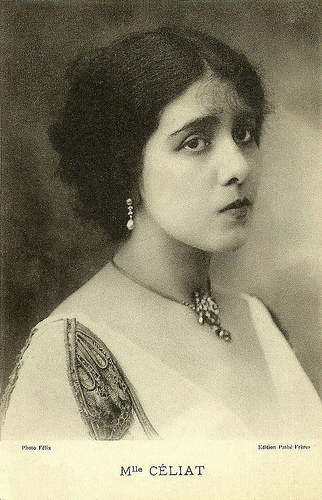
Madeleine Céliat . French postcard by Edition Pathé Frères. Photo: Félix.
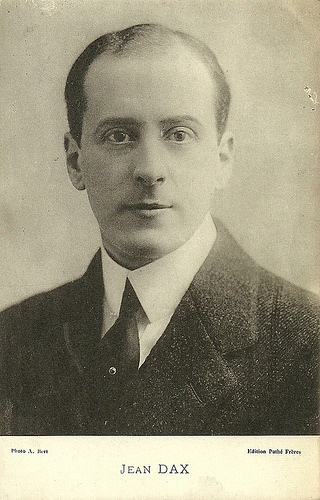
Jean Dax . French postcard by Edition Pathé Frères. Photo: A. Bert.
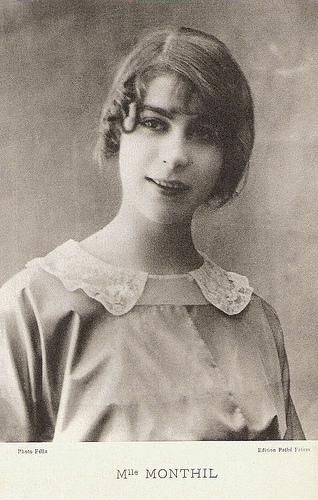
Marcelle Monthil . French postcard by Edition Pathé Frères. Photo: Félix.
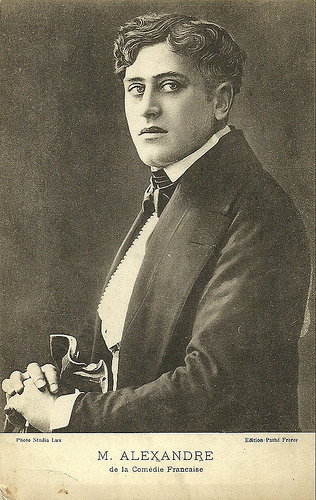
René Alexandre . French postcard by Edition Pathé Frères. Photo: Studio Lux.
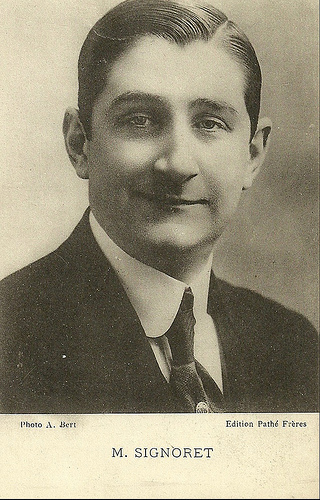
Gabriel Signoret . French postcard by Edition Pathé Frères. Photo: A. Bert.
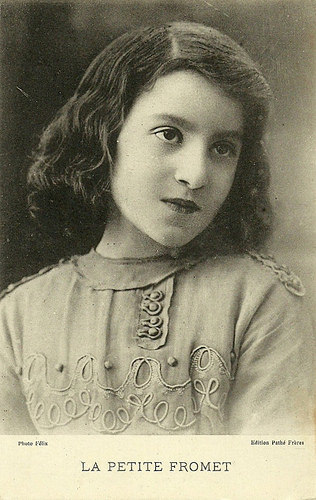
Maria Fromet . French postcard by Edition Pathé Frères. Photo: Félix.
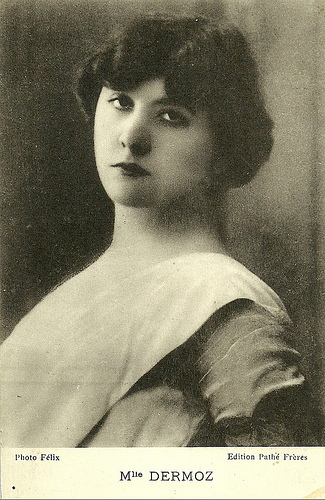
Germaine Dermoz. French postcard by Edition Pathé Frères. Photo: Félix.
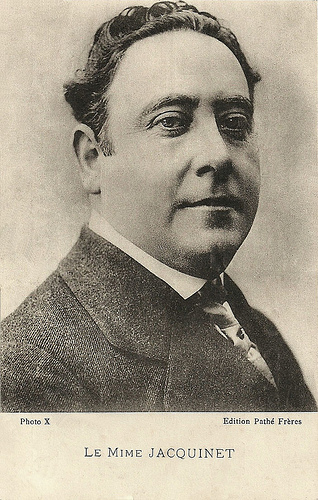
Jean Jacquinet (Le mime Jacquinet). French postcard by Edition Pathé Frères. On the back imprint, publicity for the West-Java Bioscope at Senen (now part of Jakarta), Dutch East Indies (now Indonesia).
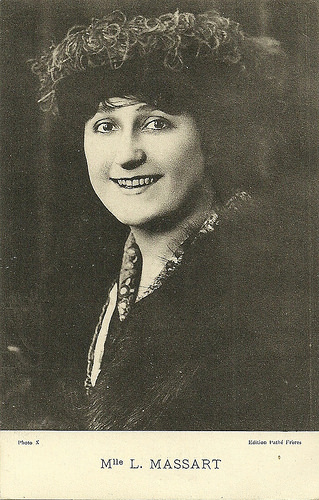
Léontine Massart . French postcard by Edition Pathé Frères. Photo: X.
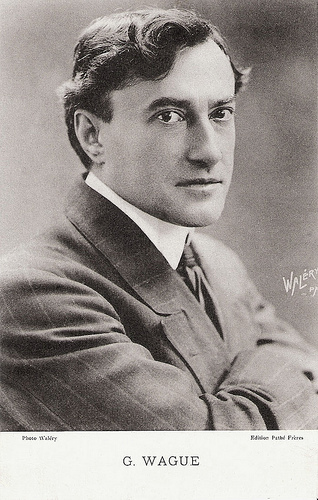
Georges Wague . French postcard by Edition Pathé Frères. Photo: Waléry, Paris.
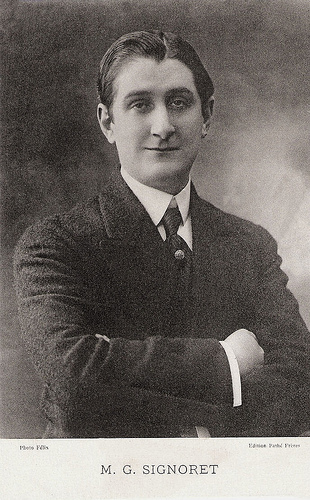
Gabriel Signoret . French postcard by Edition Pathé Frères. Photo: Félix.
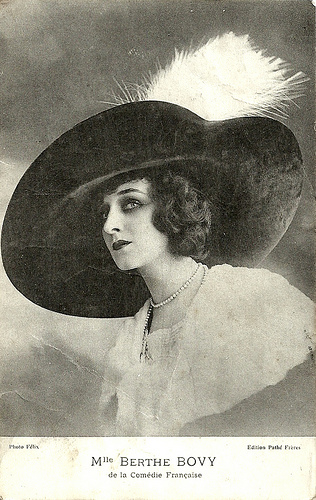
Berthe Bovy . French postcard by Edition Pathé Frères. Photo: Félix. Caption: Mlle Berthe Bovy of the Comédie Française.
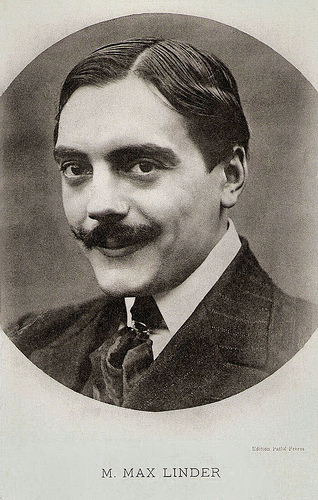
Max Linder . French postcard by Edition Pathé Frères.

Check out other postcard blogs
at Postcard Friendship Friday!
Sources: Wikipedia, Eyefilm and .

Jeanne Bérangère. French postcard by Edition Pathé Frères. Photo: Henri Manuel. A difficulty with this card, which is easily found online as well, is that it dates from around 1910-1914. French stage and screen actress Jeanne Bérangère (1864-1927) was born in 1864, so in 1914 she must have been around 50. And the woman on the postcard seems much younger. We could not trace whether Pathé used a pre-1900 photo, a photo of a relative with the same name (a daughter?), or just a photo of somebody else.

Little Moritz. French postcard by Edition Pathé Frères.

Andrée Pascal. French postcard by Edition Pathé Frères. Photo: Félix.

André Deed . French postcard by Edition Pathé Frères. Photo: X.

Léontine Massart . French postcard by Edition Pathé Frères. Photo: X.

Léon Bernard . French postcard by Edition Pathé Frères. Photo: Nadar. The Ch. must be a mistake, as this is clearly French stage and screen actor and also theatre director Léon Bernard .

Maxime Desjardins . French postcard by Edition Pathé Frères. Photo: Henri Manuel.
One of the first feature-length films about Jesus
In 1896, Pathé Frères began using the camera developed by the Lumière brothers and then Pathé set about to design an improved studio camera and to make their own film stock. From 1901, Pathé teamed up with director and later manager Ferdinand Zecca who oversaw the creation and production of original Pathé Frères films.
Pathé opened sales agencies all over the world, selling projectors, films and equipment. In 1902 it opened a glass house studio near Paris, in 1904 two other ones. At Joinville-le-Pont, also near Paris, a series of factories were built to produce cameras and projectors and to develop film stock, with a separate section for colouring films.
From 1905 on, the company employed a specialised studio staff: screenwriters, directors, cinematographers and other technicians. In 1905 Pathé produced some 12.000 meters film stock per month of positive film, by now mostly fiction films. Zecca explored many themes from the mundane to the fantastic. In À la conquête de l'air/Conquering the Skies (Ferdinand Zecca, 1901), a strange flying machine, called Fend-l'air, was seen flying over the rooftops of Belleville. By using trick photography, the one-minute short was notable in being the first aviation film, predating the flight by the Wright Brothers by two years.
Zecca also pioneered with one of the first crime dramas, Histoire d'un crime/History of a Crime (Ferdinand Zecca, 1901), stylistically innovative in its use of superimposition. The story was of a man condemned to death, awaiting execution with his crimes appearing on his cell wall. The film is an early example of flashbacks as a film device. Other Pathé films included comedies, trick films or fairy tales, such as Les Sept châteaux du Diable/The Seven Castles of the Devil (Ferdinand Zecca, 1901), and La Belle au bois dormant/Sleeping Beauty (1902).
Pathé also produced social dramas like Les Victimes de l'alcoolisme/Alcohol and Its Victims (Ferdinand Zecca, 1902), Au pays noir/Down in the Coal Mines (Lucien Nonguet, Ferdinand Zecca, 1905) and reconstructions of actual events, the most famous being La Catastrophe de la Martinique/Martinique Disaster (Ferdinand Zecca, 1902). Zecca also acted in many of his films.
Between 1900 and 1907, Zecca oversaw the production of hundreds of Pathé films from many important Pathé directors including Lucien Nonguet, Gaston Velle, Albert Capellani, Louis J. Gasnier, André Heuzé and Henri Pouctal. Zecca also acted, directed, produced, and, on occasion, wrote films. These films were at most 300 meters in length, so max. 15 minutes of screening time (which is already quite longer than the single take films of Lumière, and consisted of various shots edited together).
La Vie et la passion de Jésus Christ/Life and Passion of the Christ (Lucien Nonguet, Ferdinand Zecca, 1903) was, at a running time of 44 minutes, one of the first feature-length films about Jesus. Production grew massively: in 1906 the output of positive film stock tripled that of the year before. In 1906, Spaniard Segundo de Chomón arrived at the Pathé studio and assisted Zecca with photography and special effects. He started to colour films, such as Vie et Passion de N.S. Jésus Christ/Life and Passion of Christ (Ferdinand Zecca, 1907), shot in four parts with 38 scenes, 990 metres long. At first, the films were hand-coloured, and later semi-mechanically coloured with stencils, a method also used for colouring postcards.
After Pathé bought the rights to George Méliès's Star films, Zecca started editing the Méliès films. Film production went from 70 titles in 1901 to 500 in 1903. After 1906, the mass film production gradually eased as longer films were produced. Pathé and Méliès started to work together in 1911. Georges Méliès's first film to be distributed by Pathé was the fantasy-comedy Les aventures de baron de Munchhausen/Baron Munchausen's Dream (Georges Méliès, 1911).
Pathé Frères filmed numerous short subjects, the majority of which are sensational criminal adventures, melodramatic love stories, and comedies. In 1912 Pathé produced its first feature film, Les Misérables (Albert Capellani, 1912), a four-reel screen version of the novel by Victor Hugo starring Henry Krauss as Jean Valjean and Maria Fromet as Cosette. In 1912, Pathé appointed Alfred Machin to develop the first studio films at Sint-Jans-Molenbeek, Château Karreveld, Belgium. And in 1914, Pathé Frères studios in the United States released the first episodes of The Perils of Pauline (Louis J. Gasnier, Donald MacKenzie, 1914) featuring Pearl White, one of the earliest and best remembered screen serials.

Charles Prince . French postcard by Edition Pathé Frères. Photo: A. Bert.

Madeleine Céliat . French postcard by Edition Pathé Frères. Photo: Félix.

Jean Dax . French postcard by Edition Pathé Frères. Photo: A. Bert.

Marcelle Monthil . French postcard by Edition Pathé Frères. Photo: Félix.

René Alexandre . French postcard by Edition Pathé Frères. Photo: Studio Lux.

Gabriel Signoret . French postcard by Edition Pathé Frères. Photo: A. Bert.

Maria Fromet . French postcard by Edition Pathé Frères. Photo: Félix.

Germaine Dermoz. French postcard by Edition Pathé Frères. Photo: Félix.

Jean Jacquinet (Le mime Jacquinet). French postcard by Edition Pathé Frères. On the back imprint, publicity for the West-Java Bioscope at Senen (now part of Jakarta), Dutch East Indies (now Indonesia).

Léontine Massart . French postcard by Edition Pathé Frères. Photo: X.

Georges Wague . French postcard by Edition Pathé Frères. Photo: Waléry, Paris.

Gabriel Signoret . French postcard by Edition Pathé Frères. Photo: Félix.

Berthe Bovy . French postcard by Edition Pathé Frères. Photo: Félix. Caption: Mlle Berthe Bovy of the Comédie Française.

Max Linder . French postcard by Edition Pathé Frères.

Check out other postcard blogs
at Postcard Friendship Friday!
Sources: Wikipedia, Eyefilm and .
Published on November 03, 2017 23:00
November 2, 2017
Hilde Wörner
Hilde Wörner (1895-1963) was a German stage and film actress, who also worked as a filmmaker. She appeared mainly in silent films, had her own series and her most notable film was Ernst Lubitsch’s Die Flamme (1922).
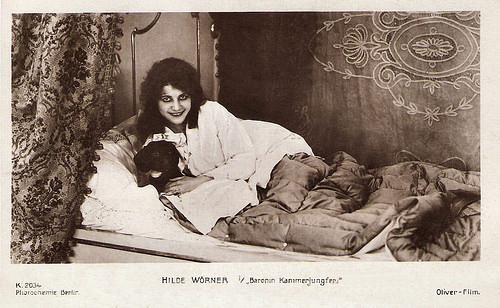
German postcard by Photochemie, no. K. 2034. Photo: Oliver-Film. Publicity still for Baronin Kammerjungfer/Baroness Kammerjungfer (Leo Peukert, 1917).
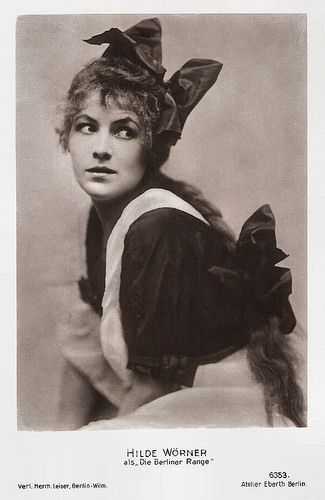
German postcard by Verlag Hermann Leiser, Berlin, no. 6253. Photo: Atelier Eberth, Berlin. Publicity still for Die Berliner Range/The Berlin Urchin (Carl Müller-Hagen, 1919-1921).
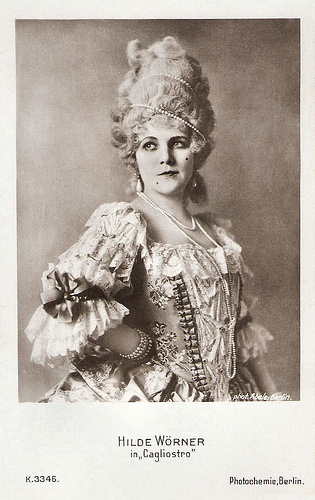
German postcard by Photochemie, no. K. 3346. Photo Abele, Berlin. Hilde Wörner in the German-Austrian coproduction Der Graf von Cagliostro (Reinhold Schünzel, 1919-1920).
The highest thing a film diva strives for
Hilde Wörner was born as Hilde Wörner-Lichtenstein.in 1895. The place of birth is unknown.
At 16, Wörner began her stage career in Elberfeld (toady a part of Wuppertal). In 1912, Johannes Maurach brought her to the Stadttheater in Essen. Later followed engagements at the theatres of Oldenburg and Bremen.
In the late phase of the First World War, she reached Berlin, where she succeeded Lisa Weise in the operetta ensemble of the Berliner Theater. There she was the first soubrette.
Almost at the same time, Heinrich Bolten-Baeckers, director of the Oliver Filmgesellschaft, signed her for the cinema. Wörner made her film debut in the silent film Baronin Kammerjungfer/Baroness Kammerjungfer (Leo Peukert, 1917). She immediately had the status of a ‘series star’. "This is the highest thing a film diva strives for," said Wörner in 1919.
She specialised in the role of youthful salon ladies and played in both dramas and comedies. However, according to German Wikipedia , she was regarded as a mediocre actress. In 1919, Hilde Wörner founded the Filmproduktionsgesellschaft Wörner-Film in Berlin, which produced various feature films until 1923.
At that time, Wörner was married to the silent film director Carl Müller-Hagen, who directed many of her films, such as the six-part series Die Berliner Range/The Berlin Urchin (1919-1921) and the crime costume drama Moriturus (1920) with Max Landa , as detective, Reinhold Schünzel in the title role, and Conrad Veidt as the criminal.
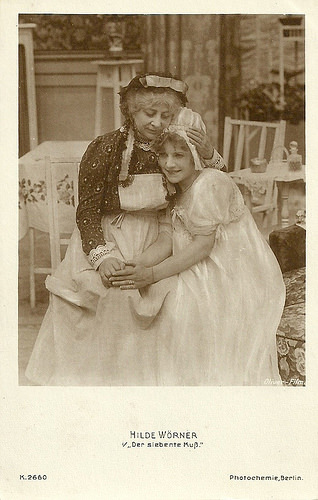
German postcard by Photochemie, no. K.2660. Photo: Oliver-Film. Hilde Wörner in Der siebente Kuß/The Seventh Kiss (1918). Director unknown.
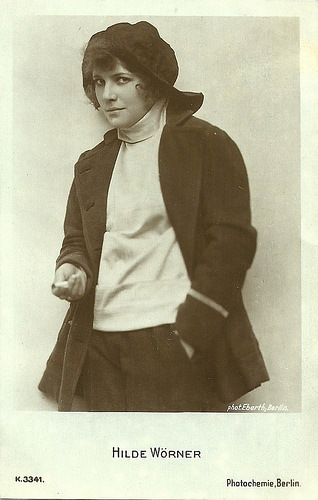
German postcard by Photochemie, no. K. 3341. Photo: Eberth, Berlin.
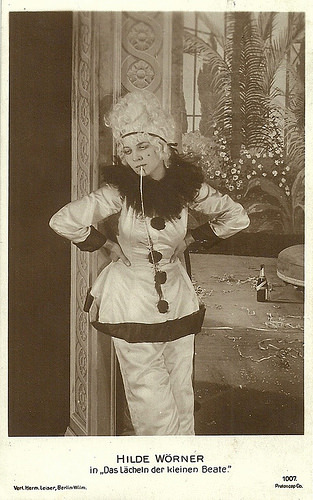
German postcard by Verlag Hermann Leiser, no. 1007. Photo: Protoscop Co. Hilde Wörner in Das Lächeln der kleinen Beate/The Smile of Little Beate (Georg Schubert, 1919).
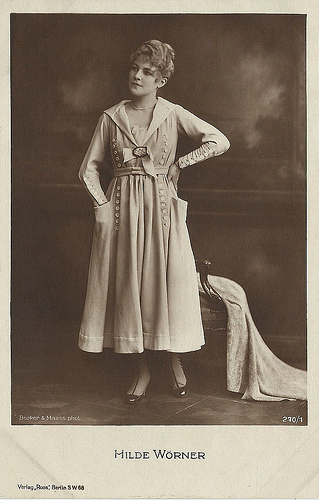
German postcard by Ross Verlag, Berlin, no. 270/1. Photo: Becker & Maass, Berlin. Collection: Didier Hanson.
Ernst Lubitsch's last German film
In 1920, Hilde Wörner appeared in the Austrian-German production Der Graf von Cagliostro/The Count of Cagliostro (Reinhold Schünzel, 1920), in which director Reinhold Schünzel played the role of the eighteenth century Italian adventurer Alessandro Cagliostro opposite Anita Berber and Conrad Veidt .
With her small film company she produced Russian director Dimitri Buchowetzki’s historical drama Danton (1921) with Emil Jannings as Danton and Werner Krauss as Robespierre. Based on the play Danton's Death by Georg Büchner, the film tells how during his reign of terror, Robespierre orchestrates the trial and execution of several of his fellow leading French revolutionaries including Georges Danton.
Wörner also produced his version of William Shakespeare’s Othello (Dimitri Buchowetzki, 1922), again with Emil Jannings and Werner Krauss .
At the side of Pola Negri , Wörner played the second female starring role in Die Flamme/The Flame/Montmartre (Ernst Lubitsch, 1923), which she also produced. It was Ernst Lubitsch 's last German film before he moved to Hollywood.
Then Wörner retired from the film business and continued to work in the theatre. In 1926, she returned seen in a supporting role in Rosen aus dem Süden/Roses from the south (Carl Froelich, 1926), starring Henny Porten .
In 1930, she appeared in small parts in two sound films, the musical comedy Einbrecher/Burglars (Hanns Schwarz, 1930) with Willy Fritsch and Lilian Harvey , and the historical film Das Flötenkonzert von Sans-souci/The Flute Concerto of Sans-Souci (Gustav Ucicky, 1930) starring Otto Gebühr as Friedrich II (aka Frederick the Great). It was part of the popular cycle of Prussian films.
It was her last film appearance. Wörner married tenor Eduard Lichtenstein and performed with him at the Metropol Theater in Berlin. After the rise of the Nazis, the Jewish Lichtenstein and his wife moved to the Netherlands where they lived in Amsterdam. In the summer of 1933, she appeared in Kabarett der Prominenten, founded by Willy Rose. She also played in Rosen’s comedy Der Chauffeur meiner Frau (My Wife's Chauffeur) in the Netherlands.
About what later happened to her is little known, but that she married the Dutch conductor Jan Koetsier. In 1949, she translated for him a musical play based on Frederik van Eeden’s play Frans Hals/Een vrolijk geval (Frans Hals – a cheerful case) into German.
Hilde Wörner passed away in 1963. She was 67.
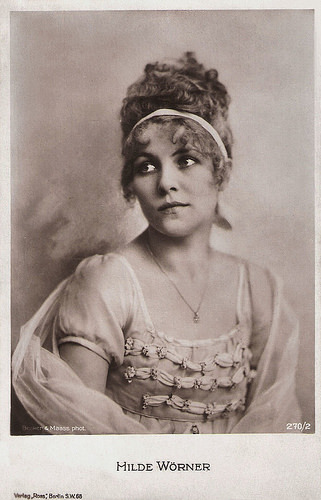
German postcard by Ross Verlag, no. 270/2, 1919-1924. Photo: Becker & Maass.
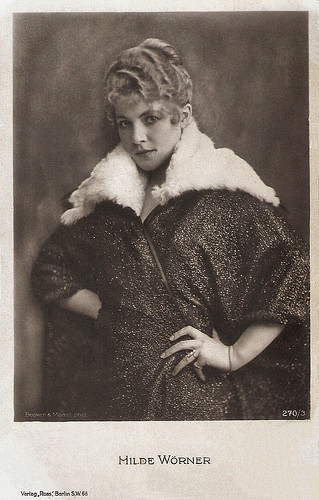
German postcard by Ross Verlag, no. 270/3, 1919-1924. Photo: Becker & Maass.
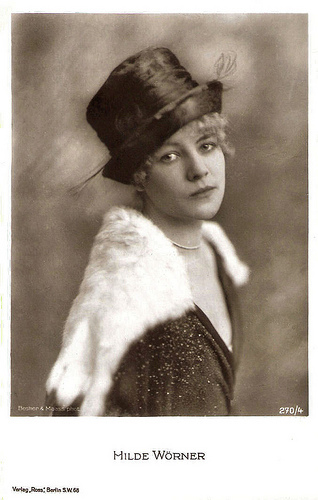
German postcard by Ross Verlag, no. 270/4, 1919-1924. Photo: Becker & Maass.
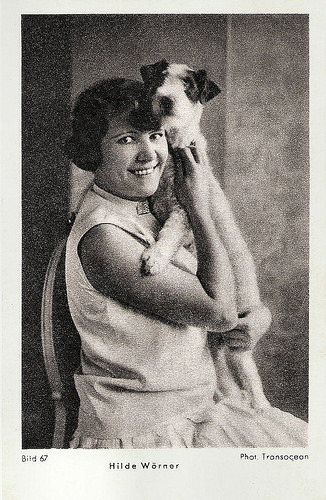
German postcard by Margarinewerk Eidelstedt Gebr. Fauser G.m.b.H., Holstein, Serie 1, no. Bild 67. Photo: Transocean.
Sources: Stephanie D’heil (Steffie-line - German), Nederlands Muziek Instituut (Dutch and German), Wikipedia (German) and .

German postcard by Photochemie, no. K. 2034. Photo: Oliver-Film. Publicity still for Baronin Kammerjungfer/Baroness Kammerjungfer (Leo Peukert, 1917).

German postcard by Verlag Hermann Leiser, Berlin, no. 6253. Photo: Atelier Eberth, Berlin. Publicity still for Die Berliner Range/The Berlin Urchin (Carl Müller-Hagen, 1919-1921).

German postcard by Photochemie, no. K. 3346. Photo Abele, Berlin. Hilde Wörner in the German-Austrian coproduction Der Graf von Cagliostro (Reinhold Schünzel, 1919-1920).
The highest thing a film diva strives for
Hilde Wörner was born as Hilde Wörner-Lichtenstein.in 1895. The place of birth is unknown.
At 16, Wörner began her stage career in Elberfeld (toady a part of Wuppertal). In 1912, Johannes Maurach brought her to the Stadttheater in Essen. Later followed engagements at the theatres of Oldenburg and Bremen.
In the late phase of the First World War, she reached Berlin, where she succeeded Lisa Weise in the operetta ensemble of the Berliner Theater. There she was the first soubrette.
Almost at the same time, Heinrich Bolten-Baeckers, director of the Oliver Filmgesellschaft, signed her for the cinema. Wörner made her film debut in the silent film Baronin Kammerjungfer/Baroness Kammerjungfer (Leo Peukert, 1917). She immediately had the status of a ‘series star’. "This is the highest thing a film diva strives for," said Wörner in 1919.
She specialised in the role of youthful salon ladies and played in both dramas and comedies. However, according to German Wikipedia , she was regarded as a mediocre actress. In 1919, Hilde Wörner founded the Filmproduktionsgesellschaft Wörner-Film in Berlin, which produced various feature films until 1923.
At that time, Wörner was married to the silent film director Carl Müller-Hagen, who directed many of her films, such as the six-part series Die Berliner Range/The Berlin Urchin (1919-1921) and the crime costume drama Moriturus (1920) with Max Landa , as detective, Reinhold Schünzel in the title role, and Conrad Veidt as the criminal.

German postcard by Photochemie, no. K.2660. Photo: Oliver-Film. Hilde Wörner in Der siebente Kuß/The Seventh Kiss (1918). Director unknown.

German postcard by Photochemie, no. K. 3341. Photo: Eberth, Berlin.

German postcard by Verlag Hermann Leiser, no. 1007. Photo: Protoscop Co. Hilde Wörner in Das Lächeln der kleinen Beate/The Smile of Little Beate (Georg Schubert, 1919).

German postcard by Ross Verlag, Berlin, no. 270/1. Photo: Becker & Maass, Berlin. Collection: Didier Hanson.
Ernst Lubitsch's last German film
In 1920, Hilde Wörner appeared in the Austrian-German production Der Graf von Cagliostro/The Count of Cagliostro (Reinhold Schünzel, 1920), in which director Reinhold Schünzel played the role of the eighteenth century Italian adventurer Alessandro Cagliostro opposite Anita Berber and Conrad Veidt .
With her small film company she produced Russian director Dimitri Buchowetzki’s historical drama Danton (1921) with Emil Jannings as Danton and Werner Krauss as Robespierre. Based on the play Danton's Death by Georg Büchner, the film tells how during his reign of terror, Robespierre orchestrates the trial and execution of several of his fellow leading French revolutionaries including Georges Danton.
Wörner also produced his version of William Shakespeare’s Othello (Dimitri Buchowetzki, 1922), again with Emil Jannings and Werner Krauss .
At the side of Pola Negri , Wörner played the second female starring role in Die Flamme/The Flame/Montmartre (Ernst Lubitsch, 1923), which she also produced. It was Ernst Lubitsch 's last German film before he moved to Hollywood.
Then Wörner retired from the film business and continued to work in the theatre. In 1926, she returned seen in a supporting role in Rosen aus dem Süden/Roses from the south (Carl Froelich, 1926), starring Henny Porten .
In 1930, she appeared in small parts in two sound films, the musical comedy Einbrecher/Burglars (Hanns Schwarz, 1930) with Willy Fritsch and Lilian Harvey , and the historical film Das Flötenkonzert von Sans-souci/The Flute Concerto of Sans-Souci (Gustav Ucicky, 1930) starring Otto Gebühr as Friedrich II (aka Frederick the Great). It was part of the popular cycle of Prussian films.
It was her last film appearance. Wörner married tenor Eduard Lichtenstein and performed with him at the Metropol Theater in Berlin. After the rise of the Nazis, the Jewish Lichtenstein and his wife moved to the Netherlands where they lived in Amsterdam. In the summer of 1933, she appeared in Kabarett der Prominenten, founded by Willy Rose. She also played in Rosen’s comedy Der Chauffeur meiner Frau (My Wife's Chauffeur) in the Netherlands.
About what later happened to her is little known, but that she married the Dutch conductor Jan Koetsier. In 1949, she translated for him a musical play based on Frederik van Eeden’s play Frans Hals/Een vrolijk geval (Frans Hals – a cheerful case) into German.
Hilde Wörner passed away in 1963. She was 67.

German postcard by Ross Verlag, no. 270/2, 1919-1924. Photo: Becker & Maass.

German postcard by Ross Verlag, no. 270/3, 1919-1924. Photo: Becker & Maass.

German postcard by Ross Verlag, no. 270/4, 1919-1924. Photo: Becker & Maass.

German postcard by Margarinewerk Eidelstedt Gebr. Fauser G.m.b.H., Holstein, Serie 1, no. Bild 67. Photo: Transocean.
Sources: Stephanie D’heil (Steffie-line - German), Nederlands Muziek Instituut (Dutch and German), Wikipedia (German) and .
Published on November 02, 2017 23:00
November 1, 2017
Der Ring der drei Wünsche (1918)
Famous stage actor Alexander Moissi played in Der Ring der drei Wünsche (Arthur Wellin, 1918) a hunchback who obtains a wishing ring: youth, beauty and health. Moissi's co-actors were Ria Jende and Eduard von Winterstein. The German silent film was produced by Rudolf Dworsky for Amboss-Film and Dworsky Co. and scripted by Hans Land (pseudonym of Hugo Landsberger) and Emil Rameau.
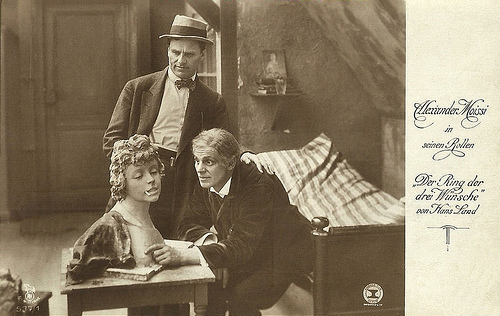
German postcard in the Film-Sterne series by Rotophot, no. 537/1. Publicity still for Der Ring der drei Wünsche/The Ring of the Three Wishes (Arthur Wellin, 1918) with left Alexander Moissi and Eduard von Winterstein.
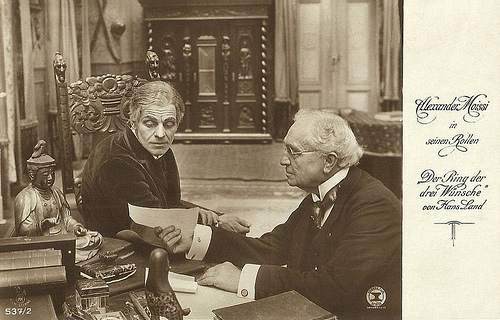
German postcard in the Film-Sterne series by Rotophot, no. 537/2. Publicity still for Der Ring der drei Wünsche/The Ring of the Three Wishes (Arthur Wellin, 1918) with Alexander Moissi .
Deported from Prague to the Lodz ghetto
Arthur Wellin (1880-prob. 1941) was a Jewish film director, born as Arthur Lewin. He had been a prolific stage director before shifting to film.
This was a reason for Austrian actor Alexander Moissi to engage him as film director for 5 films between 1918 and 1920. Wellin was also co-owner of Ambross-Film, with Rudolf Dworsky.
All in all he directed some 27 silent films, and at times also acted. In 1933 he was expelled from acting when Adolf Hitler took over in Germany. In 1941 he was deported from Prague to the Lodz ghetto in Poland, and from there probably sent to one of the extermination camps.
Hugo Landsberger (1861-reported missing 1938) was a Jewish writer, who produced several socially engaged short stories, books and plays under the pseudonym of Hans Land, while he also produced popular entertainment works such as Stürme (1909) and Staatsanwalt Jordan (1915).
From 1913 he also wrote various film scripts for films including Die Richterin/The Judge (Paul von Woringen 1917) with Lotte Neumann , Die singende Hand/The Singing Hand (Arthur Wellin 1918) with Theodor Loos , and Die Sünde/The Sin (Alwin Neuss, 1918) with Ressel Orla . Land also acted occasionally, and directed the film Stürme/Storms (Hugo Landsberger, 1913), based on his own work.

German postcard in the Film-Sterne series by Rotophot, no. 537/3. Publicity still for Der Ring der drei Wünsche/The Ring of the Three Wishes (Arthur Wellin, 1918) with Alexander Moissi and Ria Jende .
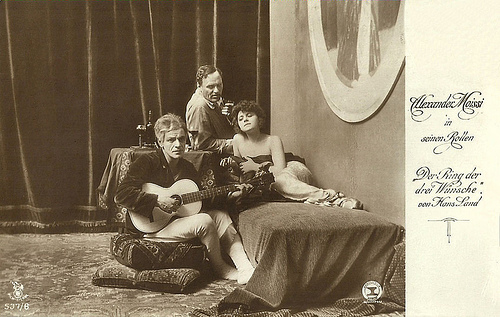
German postcard in the Film-Sterne series by Rotophot, no. 537/8. Publicity still for Der Ring der drei Wünsche/The Ring of the Three Wishes (Arthur Wellin, 1918) with Alexander Moissi, Eduard von Winterstein and Ria Jende .
Sources: The German Early Cinema Database, Wikipedia (German) and IMDb.

German postcard in the Film-Sterne series by Rotophot, no. 537/1. Publicity still for Der Ring der drei Wünsche/The Ring of the Three Wishes (Arthur Wellin, 1918) with left Alexander Moissi and Eduard von Winterstein.

German postcard in the Film-Sterne series by Rotophot, no. 537/2. Publicity still for Der Ring der drei Wünsche/The Ring of the Three Wishes (Arthur Wellin, 1918) with Alexander Moissi .
Deported from Prague to the Lodz ghetto
Arthur Wellin (1880-prob. 1941) was a Jewish film director, born as Arthur Lewin. He had been a prolific stage director before shifting to film.
This was a reason for Austrian actor Alexander Moissi to engage him as film director for 5 films between 1918 and 1920. Wellin was also co-owner of Ambross-Film, with Rudolf Dworsky.
All in all he directed some 27 silent films, and at times also acted. In 1933 he was expelled from acting when Adolf Hitler took over in Germany. In 1941 he was deported from Prague to the Lodz ghetto in Poland, and from there probably sent to one of the extermination camps.
Hugo Landsberger (1861-reported missing 1938) was a Jewish writer, who produced several socially engaged short stories, books and plays under the pseudonym of Hans Land, while he also produced popular entertainment works such as Stürme (1909) and Staatsanwalt Jordan (1915).
From 1913 he also wrote various film scripts for films including Die Richterin/The Judge (Paul von Woringen 1917) with Lotte Neumann , Die singende Hand/The Singing Hand (Arthur Wellin 1918) with Theodor Loos , and Die Sünde/The Sin (Alwin Neuss, 1918) with Ressel Orla . Land also acted occasionally, and directed the film Stürme/Storms (Hugo Landsberger, 1913), based on his own work.

German postcard in the Film-Sterne series by Rotophot, no. 537/3. Publicity still for Der Ring der drei Wünsche/The Ring of the Three Wishes (Arthur Wellin, 1918) with Alexander Moissi and Ria Jende .

German postcard in the Film-Sterne series by Rotophot, no. 537/8. Publicity still for Der Ring der drei Wünsche/The Ring of the Three Wishes (Arthur Wellin, 1918) with Alexander Moissi, Eduard von Winterstein and Ria Jende .
Sources: The German Early Cinema Database, Wikipedia (German) and IMDb.
Published on November 01, 2017 23:00
October 31, 2017
Georg Thomalla
German actor Georg Thomalla (1915-1999) was one of the most popular and prolific character comedians of the post-war German cinema. Thomalla was also known in Germany for dubbing Peter Sellers as Inspector Closeau and Jack Lemmon from 1955 to 1998.

Austrian postcard by HDH-Verlag (Verlag Hubmann), Wien, no. 4907. Photo: Fonofilm / Gloria Verleih. Publicity still for Damenwahl/Lady's Choice (E.W. Emo, 1953).

German postcard by Rüdel-Verlag, Hamburg-Bergedorff, no. 1160. Photo: Real / Europa-Film / Filipp. Publicity still for Die Stadt is voller Geheimnisse/City of Secrets (Fritz Kortner, 1955).

Austrian postcard by Austrimport, Wien, no. 142. Photo: Fono / Gloria-Film / Marczalek. Publicity still for Damenwahl/Ladies' Choice (E.W. Emo, 1953).
The second line of the German national anthem
Georg Valentin Thomalla was born in Kattowitz, Upper Silesia, German Empire, in 1915. He began his career as an apprentice cook.
In 1932, he joined a theatrical troupe and, before long, acted on stage in Berlin. With a bit part in Ihr erstes Erlebnis/Her First Experience (Josef von Báky, 1939), he made his film debut.
During the Second World War he appeared in the propaganda film Über alles in der Welt/Above All Else in the World (Karl Ritter, 1941) starring Paul Hartmann , Hannes Stelzer and Fritz Kampers. The title refers to the second line of the German national anthem. Following the outbreak of war, Germans abroad face persecution from the British and French authorities. The drama was designed to promote Nazi Germany's war aims in the Second World War.
Thomalla had a supporting part in the revue film Wir machen Musik/We Make Music (Helmut Käutner, 1942), starring Ilse Werner and Viktor de Kowa . He had a smaller part in the Henrik Ibsen adaptation Nora/A Doll's House (Harald Braun, 1944) starring Luise Ullrich , Viktor Staal and Franziska Kinz.
Rhomalla had a bigger part in the drama Solistin Anna Alt/Anna Alt (Werner Klingler, 1945). Anneliese Uhlig featured as a gifted pianist gives up her career to support her composer husband ( Will Quadflieg ). It was one of comparatively few films released in Nazi Germany in 1945, due to increasing difficulties of film production during the later stages of the Second World War.
After the war premiered the crime comedy Peter Voss, der Millionendieb/Peter Voss, Thief of Millions (Karl Anton, 1946) starring Viktor de Kowa . It was filmed between 1943 and 1945. The comedy Sag' die Wahrheit/Tell the Truth (Helmut Weiss, 1946), starring Gustav Fröhlich and Mady Rahl , had a troubled production. It was originally filming in the final days of the Nazi era with Heinz Rühmann and his wife Hertha Feiler in the lead roles, but production was halted when Soviet forces took control of the Tempelhof Studios during the Battle of Berlin. The film was then remade in the British sector of Berlin with different leads but using substantial amounts of footage already shot during the previous production.
Thomalla’s next film was the comedy Herzkönig/King of Hearts (Helmut Weiss, 1947), starring Hans Nielsen.The film was the first production of Artur Brauner's CCC Films, which would develop into a leading company in West German cinema. The film was made at the Tempelhof Studios in Berlin.
He played another supporting role in the comedy Man spielt nicht mit der Liebe/Don't Play with Love (Hans Deppe, 1949) starring Lil Dagover and Albrecht Schoenhals . On stage, he became a celebrated star of cabaret, and was an ensemble member of the Kabarett der Komiker (Cabaret of the comedians) from 1948 to 1956.

German postcard by Kunst und Bild, Berlin, no. A 984. Photo: Algefa / Constantin Film / Arthur Grimm. Publicity still for Bezauberndes Fräulein/Glamorous Miss (Georg Thomalla, 1953).

German postcard by Graphima, Berlin.
Two struggling musicians who join a women’s orchestra
In 1951, Georg Thomalla had his breakthrough in the cinema as one of the two struggling musicians who join a women’s orchestra in drag in the West German comedy Fanfaren der Liebe/Fanfares of Love (Kurt Hoffmann, 1951). The film, in which he co-starred with Dieter Borsche and Inge Egger , is a remake of the French film Fanfare d'amour/Fanfare of Love (Richard Pottier, 1935).
Later followed the most famous remake, Some Like It Hot (Billy Wilder, 1959) with Jack Lemmon in Thomalla’s role. For the German release of Some Like It Hot, Thomalla dubbed Lemmon’s character. Thomalla was well known in Germany as a voice-over artist, dubbing particularly comedians. He was the standard German dubbing voice of Jack Lemmon from 1955 to 1998. After Thomalla had dubbed Lemmon for more than 40 years, the two met at the 1996 Berlin International Film Festival where Thomalla held an honorific speech for Lemmon.
Fanfaren der Liebe was a major hit, and a sequel Fanfare of Marriage/Fanfaren der Ehe (Hans Grimm, 1953) followed, showing the further adventures of the main characters.
From then on, Thomalla co-starred in a series of light entertainment films. According to I.S. Mowis at IMDb , these films “benefited from his considerable improvisational skills, quick wit and staccato delivery. His stock-in-trade screen personae were eccentric, befuddled and generally accident-prone bachelors, or out-of-their-depths fathers or husbands, who usually tended to fall victim to their own ineptitude.”
Bei Dir war es immer so schön/It Was Always So Nice With You (Hans Wolff, 1954) for example is a West German musical comedy starring Heinz Drache. In the crime comedy Meine Tante, deine Tante/My Aunt, Your Aunt (Carl Boese, 1956), he co-starred with Theo Lingen and Hans Moser .
He also co-starred in the remake Viktor und Viktoria/Victor and Victoria (Karl Anton, 1957) with Johanna von Koczian as a woman, who gains success on the stage by pretending to be a female impersonator. The film was a remake of Viktor und Viktoria/Victor and Victoria (Reinhold Schünzel, 1933) with Renate Müller and Hermann Thimig in the role Thomalla took over. In 1982 Blake Edwards remade the film as Victor/Victoria and then based a stage musical on the film both starring Julie Andrews .
Apart from comic side-kicks, Thomalla played his fair share of friends of the hero, a noteworthy example being Kara Ben Nemsi's ( Viktor Staal ) loquacious, but intensely loyal manservant and companion Hadschi Halef Omar in Karl May's Die Sklavenkarawane/Caravan of Slaves (Georg Marischka, Ramón Torrado, 1958).
Though rarely seen in 'serious' roles, Thomalla gave a sensitive dramatic performance as a helpful truck driver in the East-West romance Himmel ohne Sterne/Sky Without Stars (Helmut Käutner, 1955). A popular success was the romantic comedy Scampolo (Alfred Weidenmann, 1958) with the young Romy Schneider .
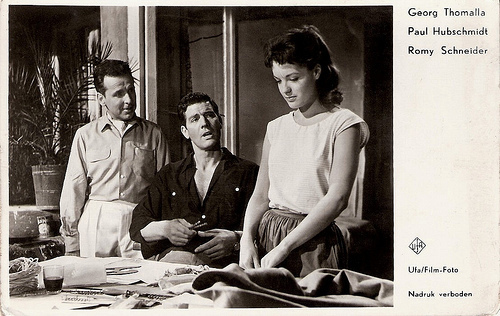
Dutch Postcard by Gebr. Spanjersberg N.V., Rotterdam. Photo: Ufa/Film-Foto for Scampolo (Alfred Weidenmann, 1958) with Paul Hubschmid and Romy Schneider .

German postcard by Rüdel-Verlag. Photo: BCF / Bavaria. Publicity still for Juanito (Fernando Palacios, 1960).

East-German postcard by VEB Progress Filmvertrieb, no. 1547, 1961. Photo: publicity still for Das Spukschloss im Spessart/The Haunted Castle (Kurt Hoffmann, 1960) with Liselotte Pulver and Curt Bois.
Schlager and Operetta Films
In 1960, Georg Thomalla co-starred with Liselotte Pulver in the comedy Das Spukschloß im Spessart/The Haunted Castle (Kurt Hoffmann, 1960). It was entered into the 2nd Moscow International Film Festival where it won the Silver Prize. The film is a sequel to Das Wirtshaus im Spessart/The Spessart Inn (Kurt Hoffmann, 1958) and was followed by Herrliche Zeiten im Spessart/Glorious Times in the Spessart Inn (1967).
Thomalla also appeared in the Schlagerfilm Ramona (Paul Martin, 1961) with Senta Berger and The Blue Diamonds , the comedy Bei Pichler stimmt die Kasse nicht/Pichler's Books Are Not in Order (Hans Quest, 1961) with Theo Lingen , and Der Traum von Lieschen Müller/The Dream of Lieschen Mueller (Helmut Käutner, 1961) featuring Sonja Ziemann .
Then followed two Operetta films Die Försterchristel/The Forester's Daughter (Franz Josef Gottlieb, 1962), starring Sabine Sinjen and Peter Weck , and Der Vogelhändler/The Bird Seller (Géza von Cziffra, 1962) with Conny Froboess .
Later, his film parts became smaller such as in Lausbubengeschichten/Tales of a Young Scamp (Helmut Käutner, 1964) with Hansi Kraus, the romantic comedy Ich suche einen Mann/I Am Looking for a Man (Alfred Weidenmann, 1966), and the comedy Zur Hölle mit den Paukern (Werner Jacobs, 1968), starring Hansi Kraus and Theo Lingen .
From 1961, Thomalla devoted more and more time to appearing in television and to voice-over work. He starred in his own half-hourly TV show, Komische Geschichten mit Georg Thomalla (1961-1971), in which he played an average Joe afflicted by middle-age angst and confronted by a variety of everyday problems.
He was the German dubbing voice for Bob Hope, Danny Kaye, Jack Lemmon and Peter Sellers as Inspector Closeau in the Pink Panther films. Thomalla’s later films were mediocre comedies like Auch ich war nur ein mittelmäßiger Schüler/I Wasn't a Very Good Student Either (Werner Jacobs, 1974) about two men waiting for their wives to give birth, who reminisce about their school days, and Der Tiefstapler/The low-loader (Karl-Heinz Bieber,1978) with Gert Fröbe.
In 1985, Thomalla was awarded the German Federal Cross of Merit. He was interested in religious question and in Eastern philosophy. From the mid-1980s he was a member of the ISKCON (the Hare Krishna movement). His final film was Lilien in der Bank/Lilies in the bank (Marianne Rosenbaum, Gérard Samaan, 1996) with Katharina Thalbach and Nina Hagen.
Georg Thomalla died in 1999 of heart failure in Starnberg, Bavaria, Germany. He was 84. From 1957 he had been married to Margit Mayrl. They had two sons.

German postcard by Rüdel-Verlag, Hamburg, no. 5187. Photo: Constantin / Neue Delta / Vogelmann. Publicity still for Einer spinnt immer/One is always nutty (Franz Antel, 1971).

German autograph card.
Scene with Dieter Borsche and Georg Thomalla in Fanfaren der Liebe (1951) (No subtitles, sorry!). Source: LadyViolet7 (YouTube).
Sources: (IMDb), Wikipedia (English and German) and .

Austrian postcard by HDH-Verlag (Verlag Hubmann), Wien, no. 4907. Photo: Fonofilm / Gloria Verleih. Publicity still for Damenwahl/Lady's Choice (E.W. Emo, 1953).

German postcard by Rüdel-Verlag, Hamburg-Bergedorff, no. 1160. Photo: Real / Europa-Film / Filipp. Publicity still for Die Stadt is voller Geheimnisse/City of Secrets (Fritz Kortner, 1955).

Austrian postcard by Austrimport, Wien, no. 142. Photo: Fono / Gloria-Film / Marczalek. Publicity still for Damenwahl/Ladies' Choice (E.W. Emo, 1953).
The second line of the German national anthem
Georg Valentin Thomalla was born in Kattowitz, Upper Silesia, German Empire, in 1915. He began his career as an apprentice cook.
In 1932, he joined a theatrical troupe and, before long, acted on stage in Berlin. With a bit part in Ihr erstes Erlebnis/Her First Experience (Josef von Báky, 1939), he made his film debut.
During the Second World War he appeared in the propaganda film Über alles in der Welt/Above All Else in the World (Karl Ritter, 1941) starring Paul Hartmann , Hannes Stelzer and Fritz Kampers. The title refers to the second line of the German national anthem. Following the outbreak of war, Germans abroad face persecution from the British and French authorities. The drama was designed to promote Nazi Germany's war aims in the Second World War.
Thomalla had a supporting part in the revue film Wir machen Musik/We Make Music (Helmut Käutner, 1942), starring Ilse Werner and Viktor de Kowa . He had a smaller part in the Henrik Ibsen adaptation Nora/A Doll's House (Harald Braun, 1944) starring Luise Ullrich , Viktor Staal and Franziska Kinz.
Rhomalla had a bigger part in the drama Solistin Anna Alt/Anna Alt (Werner Klingler, 1945). Anneliese Uhlig featured as a gifted pianist gives up her career to support her composer husband ( Will Quadflieg ). It was one of comparatively few films released in Nazi Germany in 1945, due to increasing difficulties of film production during the later stages of the Second World War.
After the war premiered the crime comedy Peter Voss, der Millionendieb/Peter Voss, Thief of Millions (Karl Anton, 1946) starring Viktor de Kowa . It was filmed between 1943 and 1945. The comedy Sag' die Wahrheit/Tell the Truth (Helmut Weiss, 1946), starring Gustav Fröhlich and Mady Rahl , had a troubled production. It was originally filming in the final days of the Nazi era with Heinz Rühmann and his wife Hertha Feiler in the lead roles, but production was halted when Soviet forces took control of the Tempelhof Studios during the Battle of Berlin. The film was then remade in the British sector of Berlin with different leads but using substantial amounts of footage already shot during the previous production.
Thomalla’s next film was the comedy Herzkönig/King of Hearts (Helmut Weiss, 1947), starring Hans Nielsen.The film was the first production of Artur Brauner's CCC Films, which would develop into a leading company in West German cinema. The film was made at the Tempelhof Studios in Berlin.
He played another supporting role in the comedy Man spielt nicht mit der Liebe/Don't Play with Love (Hans Deppe, 1949) starring Lil Dagover and Albrecht Schoenhals . On stage, he became a celebrated star of cabaret, and was an ensemble member of the Kabarett der Komiker (Cabaret of the comedians) from 1948 to 1956.

German postcard by Kunst und Bild, Berlin, no. A 984. Photo: Algefa / Constantin Film / Arthur Grimm. Publicity still for Bezauberndes Fräulein/Glamorous Miss (Georg Thomalla, 1953).

German postcard by Graphima, Berlin.
Two struggling musicians who join a women’s orchestra
In 1951, Georg Thomalla had his breakthrough in the cinema as one of the two struggling musicians who join a women’s orchestra in drag in the West German comedy Fanfaren der Liebe/Fanfares of Love (Kurt Hoffmann, 1951). The film, in which he co-starred with Dieter Borsche and Inge Egger , is a remake of the French film Fanfare d'amour/Fanfare of Love (Richard Pottier, 1935).
Later followed the most famous remake, Some Like It Hot (Billy Wilder, 1959) with Jack Lemmon in Thomalla’s role. For the German release of Some Like It Hot, Thomalla dubbed Lemmon’s character. Thomalla was well known in Germany as a voice-over artist, dubbing particularly comedians. He was the standard German dubbing voice of Jack Lemmon from 1955 to 1998. After Thomalla had dubbed Lemmon for more than 40 years, the two met at the 1996 Berlin International Film Festival where Thomalla held an honorific speech for Lemmon.
Fanfaren der Liebe was a major hit, and a sequel Fanfare of Marriage/Fanfaren der Ehe (Hans Grimm, 1953) followed, showing the further adventures of the main characters.
From then on, Thomalla co-starred in a series of light entertainment films. According to I.S. Mowis at IMDb , these films “benefited from his considerable improvisational skills, quick wit and staccato delivery. His stock-in-trade screen personae were eccentric, befuddled and generally accident-prone bachelors, or out-of-their-depths fathers or husbands, who usually tended to fall victim to their own ineptitude.”
Bei Dir war es immer so schön/It Was Always So Nice With You (Hans Wolff, 1954) for example is a West German musical comedy starring Heinz Drache. In the crime comedy Meine Tante, deine Tante/My Aunt, Your Aunt (Carl Boese, 1956), he co-starred with Theo Lingen and Hans Moser .
He also co-starred in the remake Viktor und Viktoria/Victor and Victoria (Karl Anton, 1957) with Johanna von Koczian as a woman, who gains success on the stage by pretending to be a female impersonator. The film was a remake of Viktor und Viktoria/Victor and Victoria (Reinhold Schünzel, 1933) with Renate Müller and Hermann Thimig in the role Thomalla took over. In 1982 Blake Edwards remade the film as Victor/Victoria and then based a stage musical on the film both starring Julie Andrews .
Apart from comic side-kicks, Thomalla played his fair share of friends of the hero, a noteworthy example being Kara Ben Nemsi's ( Viktor Staal ) loquacious, but intensely loyal manservant and companion Hadschi Halef Omar in Karl May's Die Sklavenkarawane/Caravan of Slaves (Georg Marischka, Ramón Torrado, 1958).
Though rarely seen in 'serious' roles, Thomalla gave a sensitive dramatic performance as a helpful truck driver in the East-West romance Himmel ohne Sterne/Sky Without Stars (Helmut Käutner, 1955). A popular success was the romantic comedy Scampolo (Alfred Weidenmann, 1958) with the young Romy Schneider .

Dutch Postcard by Gebr. Spanjersberg N.V., Rotterdam. Photo: Ufa/Film-Foto for Scampolo (Alfred Weidenmann, 1958) with Paul Hubschmid and Romy Schneider .

German postcard by Rüdel-Verlag. Photo: BCF / Bavaria. Publicity still for Juanito (Fernando Palacios, 1960).

East-German postcard by VEB Progress Filmvertrieb, no. 1547, 1961. Photo: publicity still for Das Spukschloss im Spessart/The Haunted Castle (Kurt Hoffmann, 1960) with Liselotte Pulver and Curt Bois.
Schlager and Operetta Films
In 1960, Georg Thomalla co-starred with Liselotte Pulver in the comedy Das Spukschloß im Spessart/The Haunted Castle (Kurt Hoffmann, 1960). It was entered into the 2nd Moscow International Film Festival where it won the Silver Prize. The film is a sequel to Das Wirtshaus im Spessart/The Spessart Inn (Kurt Hoffmann, 1958) and was followed by Herrliche Zeiten im Spessart/Glorious Times in the Spessart Inn (1967).
Thomalla also appeared in the Schlagerfilm Ramona (Paul Martin, 1961) with Senta Berger and The Blue Diamonds , the comedy Bei Pichler stimmt die Kasse nicht/Pichler's Books Are Not in Order (Hans Quest, 1961) with Theo Lingen , and Der Traum von Lieschen Müller/The Dream of Lieschen Mueller (Helmut Käutner, 1961) featuring Sonja Ziemann .
Then followed two Operetta films Die Försterchristel/The Forester's Daughter (Franz Josef Gottlieb, 1962), starring Sabine Sinjen and Peter Weck , and Der Vogelhändler/The Bird Seller (Géza von Cziffra, 1962) with Conny Froboess .
Later, his film parts became smaller such as in Lausbubengeschichten/Tales of a Young Scamp (Helmut Käutner, 1964) with Hansi Kraus, the romantic comedy Ich suche einen Mann/I Am Looking for a Man (Alfred Weidenmann, 1966), and the comedy Zur Hölle mit den Paukern (Werner Jacobs, 1968), starring Hansi Kraus and Theo Lingen .
From 1961, Thomalla devoted more and more time to appearing in television and to voice-over work. He starred in his own half-hourly TV show, Komische Geschichten mit Georg Thomalla (1961-1971), in which he played an average Joe afflicted by middle-age angst and confronted by a variety of everyday problems.
He was the German dubbing voice for Bob Hope, Danny Kaye, Jack Lemmon and Peter Sellers as Inspector Closeau in the Pink Panther films. Thomalla’s later films were mediocre comedies like Auch ich war nur ein mittelmäßiger Schüler/I Wasn't a Very Good Student Either (Werner Jacobs, 1974) about two men waiting for their wives to give birth, who reminisce about their school days, and Der Tiefstapler/The low-loader (Karl-Heinz Bieber,1978) with Gert Fröbe.
In 1985, Thomalla was awarded the German Federal Cross of Merit. He was interested in religious question and in Eastern philosophy. From the mid-1980s he was a member of the ISKCON (the Hare Krishna movement). His final film was Lilien in der Bank/Lilies in the bank (Marianne Rosenbaum, Gérard Samaan, 1996) with Katharina Thalbach and Nina Hagen.
Georg Thomalla died in 1999 of heart failure in Starnberg, Bavaria, Germany. He was 84. From 1957 he had been married to Margit Mayrl. They had two sons.

German postcard by Rüdel-Verlag, Hamburg, no. 5187. Photo: Constantin / Neue Delta / Vogelmann. Publicity still for Einer spinnt immer/One is always nutty (Franz Antel, 1971).

German autograph card.
Scene with Dieter Borsche and Georg Thomalla in Fanfaren der Liebe (1951) (No subtitles, sorry!). Source: LadyViolet7 (YouTube).
Sources: (IMDb), Wikipedia (English and German) and .
Published on October 31, 2017 23:00
October 30, 2017
Valérie Lagrange
After a successful career, French star, singer, actress, author and writer-composer Valérie Lagrange (1942) retired from the mainstream show business and appeared in several counter culture films of the late 1960s and early 1970s.
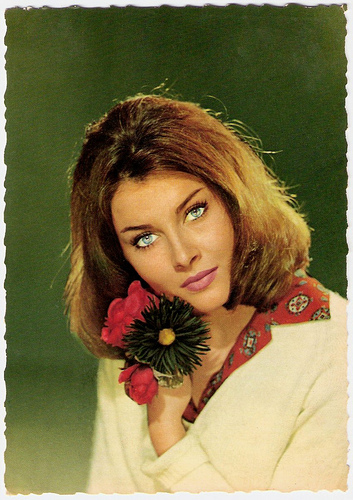
French postcard by E.D.U.G., no. 84. Photo: Sam Lévin.
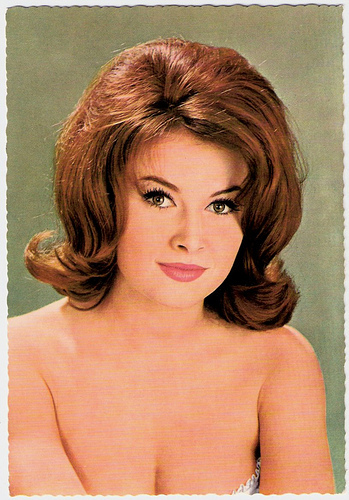
German postcard by Krüger, no. 902/140. Photo: Gérard Decaux.

French postcard by E.D.U.G., no. 268. Photo: Sam Lévin.
Protest Songs
Valérie Lagrange was born as Danielle Charaudeau in Paris, France in 1942.
She made her film debut in La Jument verte/The Green Mare (Claude Autant-Lara, 1959) at the side of the famous comedian Bourvil . Many scenes of this film take place in a barn (in French: grange) and that’s why she was renamed Valérie Lagrange.
She was influenced by the new music that arrived from the US like the rock and roll of Elvis Presley. She made several records, including the hit songs La Guérilla by Serge Gainsbourg , Encore un jour de notre amour and Le Même jour by Francis Lai and Pierre Barouh.
She listened to protest songs by Bob Dylan and Joan Baez, and discovered the Rhythm and Blues by Wilson Pickett and Otis Redding.
Meanwhile she appeared in films like Le Gigolo/The Gigolo (Jacques Deray, 1960) with Alida Valli , the anthology film La Francaise et l’amour/Love and the Frenchwoman (Michel Boisrond, 1960), and the Italian Swashbuckler Morgan il pirata/Morgan, the Pirate (André De Toth, Primo Zeglio, 1960) opposite Steve Reeves.
Later she played in the Arthur Schnitzler adaptation La Ronde/Circle of Love (Roger Vadim, 1964), in the Swashbuckler Hardi Pardaillan!/The Gallant Musketeer (Bernard Borderie, 1964) opposite Gérard Barray , and with Jean-Paul Belmondo in Les Tribulations d'un Chinois en Chine/Up to His Ears (Philippe de Broca, 1965).
Lagrange also performed on stage in Othello (1963) and Le Misanthrope (1964), and she posed for the first edition of men’s magazine Lui in November 1963.
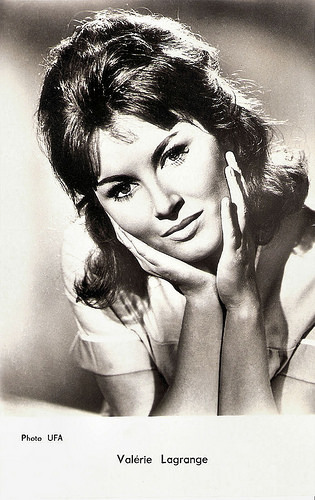
French postcard by Editions P.I., Paris, no. FK 109 A, presented by Les Carbones Korès 'Carboplane'. Photo: Ufa.
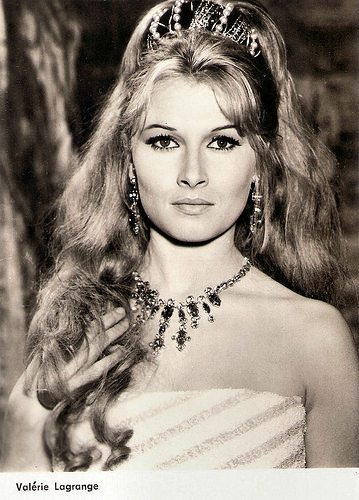
East-German postcard by VEB Progress Film-Vertrieb, Berlin, no. 2960, 1967. Photo: publicity still for Hardi Pardaillan!/The Gallant Musketeer (Bernard Borderie, 1964).
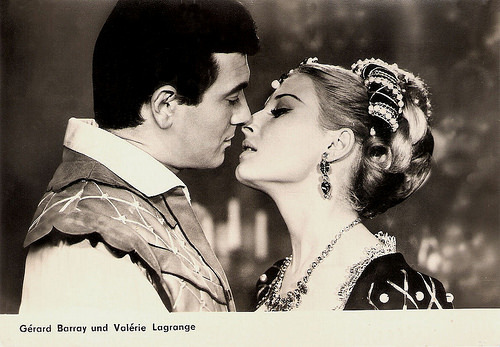
East-German postcard by Progress Film-Verleih, Berlin, no. 2961, 1967. Photo: publicity still for Hardi Pardaillan!/The Gallant Musketeer (Bernard Borderie, 1964) with Gérard Barray .
Hippie Culture
In 1966 director Claude Lelouch offered her a role in his Oscar winning drama Un homme et une femme/A Man and a Woman, and the following year Jean-Luc Godard cast her for his classic Week End/Week-end (Jean-Luc Godard, 1967). She also appeared in the Petronius adaptation Satyricon (Gian Luigi Polidoro, 1968).
After May 1968, she retired from the mainstream show business. She mixed in the hippie culture and in 1970 she recorded the first French Reggae song, Si ma chanson pouvait (1970). She went to New Guinea to play in the emblematic Beatnik film, La Vallée/The Valley (Barbet Schroeder, 1973).
She also stayed in the Provence and at the Baléares islands, and travelled through India and in Italy. Lagrange, was an authentic hippie, who felt like a spiritual sister to Jack Kerouac. In 1973 she met the British guitar player Ian Jelfs of the band Alice, with whom she performed songs by Leonard Cohen, Bob Dylan and Donovan.
Lagrange played in some films of her friend Lelouch: Le Chat et la Souris/Cat and Mouse (1975), Le Bon et les Méchants/The Good and the Bad (1976), and Si c'était à refaire/If I Had to Do It All Over Again (1976).
Her later films include Mes nuits sont plus belles que vos jours/My Nights Are More Beautiful Than Your Days (Andrzej Żuławski, 1989), and Joueuse/Queen to Play (Caroline Bottaro, 2009) with Sandrine Bonnaire and Kevin Kline.
She also appeared several times in TV series, like in The Hitchhiker (1991). In 2009, Valérie Lagrange and Ian Jelfs finally married after a long and tempestuous relationship. Lagrange published her memoirs in 2005: Mémoires d'un temps où l'on s'aimait, autobiographie, and in 2007 Philippe Malidor published the biography Besoin d'amour.

French postcard by Ste. Anne, Marseille. Photo: Sam Lévin.

French postcard by Editions P.I., Paris, no. 1056. Photo: Sam Lévin.

French postcard by Editions P.I., Paris, no. 1061. Photo: Sam Lévin.

French playing card. Photo: Sam Lévin.
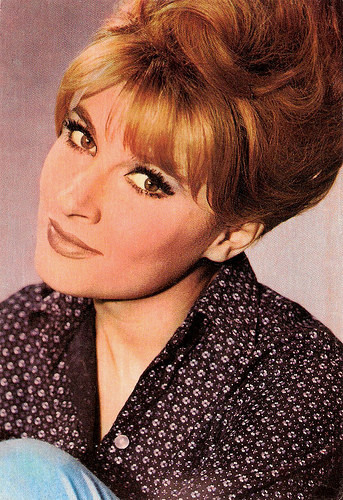
French postcard by Editions Borde, Paris, no. 125.
Vintage clip with Valerie Lagrange singing Moitié Ange Moitié Bete (1966). Source: TheoChris (Daily Motion).
Sources: Wikipedia and .

French postcard by E.D.U.G., no. 84. Photo: Sam Lévin.

German postcard by Krüger, no. 902/140. Photo: Gérard Decaux.

French postcard by E.D.U.G., no. 268. Photo: Sam Lévin.
Protest Songs
Valérie Lagrange was born as Danielle Charaudeau in Paris, France in 1942.
She made her film debut in La Jument verte/The Green Mare (Claude Autant-Lara, 1959) at the side of the famous comedian Bourvil . Many scenes of this film take place in a barn (in French: grange) and that’s why she was renamed Valérie Lagrange.
She was influenced by the new music that arrived from the US like the rock and roll of Elvis Presley. She made several records, including the hit songs La Guérilla by Serge Gainsbourg , Encore un jour de notre amour and Le Même jour by Francis Lai and Pierre Barouh.
She listened to protest songs by Bob Dylan and Joan Baez, and discovered the Rhythm and Blues by Wilson Pickett and Otis Redding.
Meanwhile she appeared in films like Le Gigolo/The Gigolo (Jacques Deray, 1960) with Alida Valli , the anthology film La Francaise et l’amour/Love and the Frenchwoman (Michel Boisrond, 1960), and the Italian Swashbuckler Morgan il pirata/Morgan, the Pirate (André De Toth, Primo Zeglio, 1960) opposite Steve Reeves.
Later she played in the Arthur Schnitzler adaptation La Ronde/Circle of Love (Roger Vadim, 1964), in the Swashbuckler Hardi Pardaillan!/The Gallant Musketeer (Bernard Borderie, 1964) opposite Gérard Barray , and with Jean-Paul Belmondo in Les Tribulations d'un Chinois en Chine/Up to His Ears (Philippe de Broca, 1965).
Lagrange also performed on stage in Othello (1963) and Le Misanthrope (1964), and she posed for the first edition of men’s magazine Lui in November 1963.

French postcard by Editions P.I., Paris, no. FK 109 A, presented by Les Carbones Korès 'Carboplane'. Photo: Ufa.

East-German postcard by VEB Progress Film-Vertrieb, Berlin, no. 2960, 1967. Photo: publicity still for Hardi Pardaillan!/The Gallant Musketeer (Bernard Borderie, 1964).

East-German postcard by Progress Film-Verleih, Berlin, no. 2961, 1967. Photo: publicity still for Hardi Pardaillan!/The Gallant Musketeer (Bernard Borderie, 1964) with Gérard Barray .
Hippie Culture
In 1966 director Claude Lelouch offered her a role in his Oscar winning drama Un homme et une femme/A Man and a Woman, and the following year Jean-Luc Godard cast her for his classic Week End/Week-end (Jean-Luc Godard, 1967). She also appeared in the Petronius adaptation Satyricon (Gian Luigi Polidoro, 1968).
After May 1968, she retired from the mainstream show business. She mixed in the hippie culture and in 1970 she recorded the first French Reggae song, Si ma chanson pouvait (1970). She went to New Guinea to play in the emblematic Beatnik film, La Vallée/The Valley (Barbet Schroeder, 1973).
She also stayed in the Provence and at the Baléares islands, and travelled through India and in Italy. Lagrange, was an authentic hippie, who felt like a spiritual sister to Jack Kerouac. In 1973 she met the British guitar player Ian Jelfs of the band Alice, with whom she performed songs by Leonard Cohen, Bob Dylan and Donovan.
Lagrange played in some films of her friend Lelouch: Le Chat et la Souris/Cat and Mouse (1975), Le Bon et les Méchants/The Good and the Bad (1976), and Si c'était à refaire/If I Had to Do It All Over Again (1976).
Her later films include Mes nuits sont plus belles que vos jours/My Nights Are More Beautiful Than Your Days (Andrzej Żuławski, 1989), and Joueuse/Queen to Play (Caroline Bottaro, 2009) with Sandrine Bonnaire and Kevin Kline.
She also appeared several times in TV series, like in The Hitchhiker (1991). In 2009, Valérie Lagrange and Ian Jelfs finally married after a long and tempestuous relationship. Lagrange published her memoirs in 2005: Mémoires d'un temps où l'on s'aimait, autobiographie, and in 2007 Philippe Malidor published the biography Besoin d'amour.

French postcard by Ste. Anne, Marseille. Photo: Sam Lévin.

French postcard by Editions P.I., Paris, no. 1056. Photo: Sam Lévin.

French postcard by Editions P.I., Paris, no. 1061. Photo: Sam Lévin.

French playing card. Photo: Sam Lévin.

French postcard by Editions Borde, Paris, no. 125.
Vintage clip with Valerie Lagrange singing Moitié Ange Moitié Bete (1966). Source: TheoChris (Daily Motion).
Sources: Wikipedia and .
Published on October 30, 2017 23:00
October 29, 2017
David Farrar
English stage and film actor David Farrar (1908-1995) with his dark and rather sinister good looks gained fame in the 1940s playing Sexton Blake in a pair of low-budget thrillers. Three of his most notable film roles were leads in the Powell and Pressburger films Black Narcissus (1947), The Small Back Room (1949) and Gone to Earth (1950).

British postcard in the Picturegoer Series, London, no. W 179. Photo: Warner.

British postcard in the Picturegoer Series, no. W 462. Photo: London Films.
800 fan letters a week
David Farrar was born in 1908 in Forest Gate, East London. At 12, he had his first stage role in A Midsummer Night's Dream by William Shakespeare. He dropped out of school at 14.
He began his career with a stint at journalism at the Morning Advertiser newspaper. Then he started to act on stage. He met his wife, Irene Elliot, in 1926 when he was playing the title role on stage in David Copperfield. They married in 1929.
In 1930 he took over the lead in The Wandering Jew in the West End, bringing notices that immediately established him as one of the most promising young leading men in the West End. With his wife he ran a repertory company until he entered films in 1937.
In the enjoyable adventure tale Sexton Blake and the Hooded Terror (George King, 1938) he was Granite Grant, an agent on the track of the crime organisation Black Quorum. He had big parts in Quota Quickies and small parts in big films like Went the Day Well? (Alberto Cavalcanti, 1942).
He starred in Ealing's semi-documentary about the Air-Sea Rescue Service, For Those in Peril (Charles Crichton, 1944). Farrar then played Sexton Blake twice in the low-budget thrillers Meet Sexton Blake (John Harlow, 1944) and The Echo Murders (John Harlow, 1945), which were enormously popular. By 1945 he was receiving 800 fan letters a week. He also made several poor films at British National, including Lisbon Story (Paul L.Stein, 1946).
In the classic Black Narcissus (Michael Powell, Emeric Pressburger, 1947), he played the district agent who - clothed only in khaki shorts - stirs up sexual tensions in a Himalayan convent. Black Narcissus achieved acclaim for its pioneering technical mastery and shocked audiences at the time of release with its vibrant colour and the themes of the film. The film won two Oscars.
For the writer-producer-director team of Michael Powell and Emeric Pressburger he also played the lame bomb-disposal expert in The Small Back Room (Michael Powell, Emeric Pressburger, 1948) and the swaggering squire in Gone to Earth (Michael Powell, Emeric Pressburger, 1950) with Jennifer Jones.
He also starred for Ealing in Frieda (Basil Dearden, 1947) as the officer who brings home a German wife ( Mai Zetterling ), and Cage of Gold (Basil Dearden, 1950) opposite Jean Simmons . In Cage of Gold, he had argued successfully with the producer Michael Balcon that he be allowed to play the villain rather than the less colourful hero. In 1949 exhibitors voted him the ninth-most popular British star.

West-German postcard by Kunst und Bild, Berlin, no. A 197. Photo: J. Arthur Rank Organisation.

British postcard in the Celebrity Autographs Series, no. 134. Photo: Republic. Publicity still for Lilacs in the Spring (Herbert Wilcox, 1954).
Hollywood came a-calling
David Farrar’s brooding good looks and deep, rich baritone won him legions of female fans in Europe and also in the USA. Hollywood came a-calling and he moved to the Universal studios where he became a contract player.
And although he enjoyed the money, glamour and star treatment, his Hollywood adventure declined his career into supporting and mainly villainous roles in undistinguished adventure and costume pictures, such as The Golden Horde (George Sherman, 1951) with Ann Blyth, and The Black Shield of Falworth (Rudolph Maté, 1954), starring Tony Curtis.
Wikipedia : “Director Michael Powell once spoke of his handsome appearance and distinctive ‘violet eyes’, and his exceptional timing in films. Powell also stated that had Farrar been more interested in cinema and cared more about his career he could have been a much more high-profile actor, as successful as any.”
After playing the Egyptian Pharaoh in Solomon and Sheba (King Vidor, 1959) featuring Yul Brynner and Gina Lollobrigida , he returned to England somewhat embittered by his Hollywood experience. He was determined to do better in his own country's film industry, but he couldn't regain the momentum he had before he left for Hollywood.
His final films were the Irish production The Webster Boy (Don Chaffey, 1962) with Richard O’Sullivan, and the historical epic The 300 Spartans (Rudolph Maté, 1962) in which he played the small part as King Xerxes of Persia. Farrar retired from the cinema in 1962 when he was just over 50.
Brian McFarlane in Encyclopedia of British Film : “He retired unwilling to play 'the heroine's father' as he did in Beat Girl (Edmond T.Gréville, 1960), depriving British cinema of an interesting mix of sneering authority and sensitivity”. He went to work for television.
After the death of his wife Irene in 1976, he moved to South Africa to be with their daughter, Barbara, and retired from acting. David Farrar died in 1995 in KwaZulu-Natal, South Africa, 10 days after his 87th birthday.

British postcard in the Picturegoer Series, London, no. W 519. Photo: Archer Film Productions.
Trailer Black Narcissus (1947). Source: ryy79 (YouTube).
Sources: Tom Vallance (Independent), Brian McFarlane (Encyclopedia of British Film), Richard Lamparski (Powell-Pressburger.or), David Stout (The New York Times), Wikipedia, and .

British postcard in the Picturegoer Series, London, no. W 179. Photo: Warner.

British postcard in the Picturegoer Series, no. W 462. Photo: London Films.
800 fan letters a week
David Farrar was born in 1908 in Forest Gate, East London. At 12, he had his first stage role in A Midsummer Night's Dream by William Shakespeare. He dropped out of school at 14.
He began his career with a stint at journalism at the Morning Advertiser newspaper. Then he started to act on stage. He met his wife, Irene Elliot, in 1926 when he was playing the title role on stage in David Copperfield. They married in 1929.
In 1930 he took over the lead in The Wandering Jew in the West End, bringing notices that immediately established him as one of the most promising young leading men in the West End. With his wife he ran a repertory company until he entered films in 1937.
In the enjoyable adventure tale Sexton Blake and the Hooded Terror (George King, 1938) he was Granite Grant, an agent on the track of the crime organisation Black Quorum. He had big parts in Quota Quickies and small parts in big films like Went the Day Well? (Alberto Cavalcanti, 1942).
He starred in Ealing's semi-documentary about the Air-Sea Rescue Service, For Those in Peril (Charles Crichton, 1944). Farrar then played Sexton Blake twice in the low-budget thrillers Meet Sexton Blake (John Harlow, 1944) and The Echo Murders (John Harlow, 1945), which were enormously popular. By 1945 he was receiving 800 fan letters a week. He also made several poor films at British National, including Lisbon Story (Paul L.Stein, 1946).
In the classic Black Narcissus (Michael Powell, Emeric Pressburger, 1947), he played the district agent who - clothed only in khaki shorts - stirs up sexual tensions in a Himalayan convent. Black Narcissus achieved acclaim for its pioneering technical mastery and shocked audiences at the time of release with its vibrant colour and the themes of the film. The film won two Oscars.
For the writer-producer-director team of Michael Powell and Emeric Pressburger he also played the lame bomb-disposal expert in The Small Back Room (Michael Powell, Emeric Pressburger, 1948) and the swaggering squire in Gone to Earth (Michael Powell, Emeric Pressburger, 1950) with Jennifer Jones.
He also starred for Ealing in Frieda (Basil Dearden, 1947) as the officer who brings home a German wife ( Mai Zetterling ), and Cage of Gold (Basil Dearden, 1950) opposite Jean Simmons . In Cage of Gold, he had argued successfully with the producer Michael Balcon that he be allowed to play the villain rather than the less colourful hero. In 1949 exhibitors voted him the ninth-most popular British star.

West-German postcard by Kunst und Bild, Berlin, no. A 197. Photo: J. Arthur Rank Organisation.

British postcard in the Celebrity Autographs Series, no. 134. Photo: Republic. Publicity still for Lilacs in the Spring (Herbert Wilcox, 1954).
Hollywood came a-calling
David Farrar’s brooding good looks and deep, rich baritone won him legions of female fans in Europe and also in the USA. Hollywood came a-calling and he moved to the Universal studios where he became a contract player.
And although he enjoyed the money, glamour and star treatment, his Hollywood adventure declined his career into supporting and mainly villainous roles in undistinguished adventure and costume pictures, such as The Golden Horde (George Sherman, 1951) with Ann Blyth, and The Black Shield of Falworth (Rudolph Maté, 1954), starring Tony Curtis.
Wikipedia : “Director Michael Powell once spoke of his handsome appearance and distinctive ‘violet eyes’, and his exceptional timing in films. Powell also stated that had Farrar been more interested in cinema and cared more about his career he could have been a much more high-profile actor, as successful as any.”
After playing the Egyptian Pharaoh in Solomon and Sheba (King Vidor, 1959) featuring Yul Brynner and Gina Lollobrigida , he returned to England somewhat embittered by his Hollywood experience. He was determined to do better in his own country's film industry, but he couldn't regain the momentum he had before he left for Hollywood.
His final films were the Irish production The Webster Boy (Don Chaffey, 1962) with Richard O’Sullivan, and the historical epic The 300 Spartans (Rudolph Maté, 1962) in which he played the small part as King Xerxes of Persia. Farrar retired from the cinema in 1962 when he was just over 50.
Brian McFarlane in Encyclopedia of British Film : “He retired unwilling to play 'the heroine's father' as he did in Beat Girl (Edmond T.Gréville, 1960), depriving British cinema of an interesting mix of sneering authority and sensitivity”. He went to work for television.
After the death of his wife Irene in 1976, he moved to South Africa to be with their daughter, Barbara, and retired from acting. David Farrar died in 1995 in KwaZulu-Natal, South Africa, 10 days after his 87th birthday.

British postcard in the Picturegoer Series, London, no. W 519. Photo: Archer Film Productions.
Trailer Black Narcissus (1947). Source: ryy79 (YouTube).
Sources: Tom Vallance (Independent), Brian McFarlane (Encyclopedia of British Film), Richard Lamparski (Powell-Pressburger.or), David Stout (The New York Times), Wikipedia, and .
Published on October 29, 2017 23:00
October 28, 2017
Germaine Dermoz
Germaine Dermoz (1888–1966) was a French film and theatre actress of the early-to-mid twentieth century. She is most famous for her portrayal of Madame Beudet in Germaine Dulac's avant-garde film La souriante Madame Beudet/The Smiling Madame Beudet (1923).

French postcard in the Nos artistes dans leur loge series, no. 210. Photo: Comoedia. While this card shows a spelling of 'Dermos' with an -s in the caption and the signature, identical cards show a caption with 'Dermoz' with a -z. No trace of any actress with the name of Germaine Dermos can be found, so this has to be Dermoz.
Crossing the Andes on the back of a donkey
Germaine Dermoz was born as Germaine Deluermoz in 1888 in Paris. She was the younger sister of Jeanne Delvourmoz, aka Jeanne Delvair (1877-1949), actress at the Comédie-Française. Their brother was animal painter Henri Deluermoz (1876-1943), illustrator, among others, of one of the first French editions of Jungle Book by Rudyard Kipling.
Germaine acted on stage with Gabrielle Réjane and stayed with Réjane’s troupe between 1907 and 1909. She also acted with Firmin Gémier . Her many theatrical tours led her, before the First World War, as far as Argentine and Russia.
Dermoz recounts in her memoirs the perilous conditions in which one day she and her comrades had to cross the Cordillera of the Andes on the back of a donkey, on the side of a mountain on narrow paths, resigning themselves to throwing a part of their costumes on the snowy slopes. In St. Petersburg, she played before Tsar Nicholas II and suffered the first shots of the October 1917 revolution. Contrary to some assertions, she never belonged to the Comédie-Française.
In 1908, Dermoz acted in the Gaumont film Méprise/Misunderstanding (Maurice de Féraudy, 1908), followed by a few more shorts by Maurice de Féraudy . Soon she would also play in films by Pathè, Éclair and Eclipse. She was especially active in the historical genre, such as in Dragonnades sous Louis XIV/The Dragoons Under Louis XIV (1909), Beethoven (1909) with Harry Baur , Eugénie Grandet (1910), and Le roi Philippe le Bel et les templiers/King Philip the Fair and the Templars (1910), which were all directed by Victorin-Hippolyte Jasset for Éclair.
She also appeared in La mort du duc d'Enghien en 1804/The Death of the Duke D'Enghien (Albert Capellani, 1909), La fin d'un tyran/The end of a tyrant (Georges Le Faure, 1909), and La duchesse de Langeais/The Duchess of Langeais (André Calmettes, 1910), for Pathé, and L'assassinat d'Henri III/An Eye for an Eye; or, The Last Days of King Henry III of France (Henri Desfontaines, Louis Mercanton, 1911), Olivier Cromwell (Henri Desfontaines, 1911) with Jules Berry , and Milton (Henri Desfontaines, 1911) for Eclipse.
After the Éclair film Le mystère de Notre-Dame de Paris/The Mystery of the Notre-Dame Bridge (Emile Chautard, Victorin-Hippolyte Jasset, 1912), Dermoz mostly acted in Pathé productions. Several were directed by Adrien Caillard, such as Les trois sultanes/The Three Sultans (1912), Zaza (1913), an adaptation of the play by Pierre Berton and Charles Simon, and L'héritage de Cabestan/Harding's Heritage (1913).
At Pathé, Dermoz often acted together with Henri Étievant and Jeanne Grumbach, as in L’absent/A Dutch Love Story (Albert Capellani, 1913), and Le petit Jacques/Little Jack (Georges Monca, 1913).

French postcard by Edition Pathé Frères. Photo: Félix.
A feminist manifesto and typical avant-garde production
After 1914, Germaine Dermoz took a break of the set. During the First World War, Pathé drastically reduced fiction film production. In 1918 Dermoz returned with the Pathé film La masque de l’amour/The Mask of Love (René Plaisetty, 1918) with Mévisto and Jeanne Grumbach, and she had the female lead in the Honoré de Balzac adaptation La marâtre/The stepmother (Jacques Grétillat, 1918).
Other adaptations followed such as L'énigme/The riddle (Jean Kemm, 1918) after Paul Hervieu, Fanny Lear (Robert Boudrioz, Jean Manoussi, 1919), after the play by Ludovic Halévy and Henri Meilhac, Les cinq gentlemen maudits/Five Doomed Gentlemen (Luitz-Morat, Pierre Régnier, 1920) after André Reuze, Petit ange/Little Angel (Luitz-Morat, Pierre Régnier, 1920) after Alfred Vercourt and with Régine Dumien .
If it were necessary to point out a single film of that period, though, it would undoubtedly be the masterpiece of Germaine Dulac, La souriante Madame Beudet/The Smiling Madame Beudet (1923), a feminist manifesto and typical avant-garde production. The film deals with an intelligent woman trapped in a loveless marriage with a man (Alexandre Arquillière), who always points an unloaded revolver at his head for fun. Sick of him, she loads the gun, but repents and tries to empty the gun. Yet, the man seizes the gun first and points it at her.
In her memoirs, Dermoz recounts the apprehension that had seized her when the film was broadcast forty years later on French television and surprised to find that her play did not have the dreaded exaggeration and grotesque that characterised a part of silent film acting.
After the female lead in the operetta film La course du flambeau/The Torch Race (Luitz-Morat, 1925), which she had performed on stage in 1907, Dermoz’s silent film career ended. Between the two wars, she preferred to devote herself almost exclusively to the theatre. She played on the biggest Parisian stages, and enjoyed successes in contemporary plays by André Josset, Henri-René Lenormand, Charles de Peyret-Chappuis and Jean Cocteau.
In 1938, Germaine Dermoz created the character of Yvonne in Les Parents terribles by Jean Cocteau, with Gabrielle Dorziat and the very young Jean Marais . The play was directed by former actress Alice Cocéa, and performed at the Théâtre des Ambassadeurs in Paris. Dermoz replaced almost instantly Yvonne de Bray for whom the role had been written but who, because of a serious heart problem, was no longer able to play.

Belgian postcard for the Ghent cinema Rex. Photo: publicity still for La porteuse de pain/The Bread Peddler (René Sti, 1934) with Germaine Dermoz as Jeanne Fortier.

Belgian postcard for the Ghent cinema Rex. Photo: publicity still for La porteuse de pain/The Bread Peddler (René Sti, 1934) with Germaine Dermoz as Jeanne. Caption: "Follow me Jeanne, soon I'll be rich". Collection: Didier Hanson.
An innocently imprisoned woman
Germaine Dermoz led a more relaxed film career, accepting shooting proposals only if they did not compromise her commitments to the theatre. When sound film set in in France she returned to the film set for supporting parts in Jacques de Baroncelli’s Alphonse Daudet adaptation L'Arlésienne (Jacques de Baroncelli, 1930), starring Blanche Montel , and Le rêve/The Dream (Jacques de Baroncelli, 1931) after Émile Zola.
Dermoz had the lead as Madame Kampf in Le bal/The Ball (Wilhelm Thiele, 1931), in which she played a middle-class woman who just like her husband (André Lefaur) turns into a snob when an inheritance looms. Their daughter ( Danielle Darrieux in her first film role) torpedoes the plans when she throws all the invitations to the ball her parents organise in the Seine. The film was shot in a German version too by Thiele, Der Ball.
After the court case drama Le crime du chemin rouge/The Crime of the Red Road (Jacques Séverac, 1933), in which a lawyer ( Marcel Vibert ) suspects his wife (Dermoz) of murder, Dermoz had an endearing part in La porteuse de pain/The Bread Peddler (René Sti, 1934), as an innocently imprisoned woman, who after twenty years of hard labour, evades and goes to Paris where she survives as bread peddler. She finds back her children one by one, after which she unmasks the culprit, Jacques Garaud (Jacques Grétillat).
By now Dermoz often played mature roles, as Annabella’s meddling mother in Les nuits moscovites/Moscow Nights (Alexis Granowsky, 1934), the wife of Fernand Charpin in the Mauriac adaptation Les anges noirs/The Black Angels (Willy Rozier, 1937), the wife of Raimu in Le héros de la Marne/Heroes of the Marne (André Hugon, 1938), Maria de Medici in Remontons les Champs-Élysées (Sacha Guitry, 1938), the mother of Katia Lova in La vie est magnifique/Life is magnificent (Maurice Cloche, 1939), the mother of Jean Chévrier in the smugglers drama Andorra ou les hommes d’airain/Andorra or the Bronze Men (Émile Couzinet, 1942), and Raymond Rouleau ’s mother and Constant Rémy’s wife in Monsieur des Lourdines (Pierre de Hérain, 1943) after Chateaubriant.
After the war, Germaine Dermoz was Queen Anne of Austria in Monsieur Vincent (Maurice Cloche, 1947) on St. Vincent de Paul, played by Pierre Fresnay . In the comedy Le Rosier de Madame Husson/The Rosier of Madame Husson (Jean Boyer, 1950), after Guy de Maupassant’s classic tale, she leads a group of charitable ladies searching for a chaste girl, who will win a big sum of money. By lack of a chaste female they select a man ( Bourvil ), who, though, proves to be weak against female seductions.
In Poil de carotte/Carrot Top (Paul Mesnier, 1952), she was the ill-doing, hateful mother of the protagonist (Christian Simon). After a few minor parts, Dermoz almost made full circle with her early historical films when playing Catherine de Medici in Si Versailles m’était conté/If Paris Were Told to Us (Sacha Guitry, 1955), though two more minor parts followed. Dermoz’s last film part was in the spy comedy L'Honorable Stanislas, agent secret/The Reluctant Spy (Jean-Charles Dudrumet, 1963) as the mother of Stanislas ( Jean Marais ). Her stage career had already ended in the mid-1950s.
After a first marriage, Germaine Dermoz married in second wedding the actor Jean Galland, whom she then divorced. From her first marriage, Germaine Dermoz had a daughter, Claude, and from her second, another daughter, Anne-Marie. She was also, by her first marriage, the aunt by marriage of the actress Annabella , called "Zette" for the intimates, with whom she maintained affectionate ties until the end of her life. The journalist Hélène Lazareff, comedian Noël Roquevert and his wife, and the actress Paulette Noizeux were among the close friends of Germaine Dermoz.
Germaine Dermoz died in 1966 in Paris.

Belgian postcard for the Ghent cinema Rex. Photo: publicity still for La porteuse de pain/The Bread Peddler (René Sti, 1934) with Germaine Dermoz as Jeanne. Caption: "Our father who art in heaven". Collection: Didier Hanson.

Belgian postcard for the Ghent cinema Rex. Photo: publicity still for La porteuse de pain/The Bread Peddler (René Sti, 1934) with Germaine Dermoz. Caption: "Father, bless me". Collection: Didier Hanson.
Source: Wikipedia (French and English) and .

French postcard in the Nos artistes dans leur loge series, no. 210. Photo: Comoedia. While this card shows a spelling of 'Dermos' with an -s in the caption and the signature, identical cards show a caption with 'Dermoz' with a -z. No trace of any actress with the name of Germaine Dermos can be found, so this has to be Dermoz.
Crossing the Andes on the back of a donkey
Germaine Dermoz was born as Germaine Deluermoz in 1888 in Paris. She was the younger sister of Jeanne Delvourmoz, aka Jeanne Delvair (1877-1949), actress at the Comédie-Française. Their brother was animal painter Henri Deluermoz (1876-1943), illustrator, among others, of one of the first French editions of Jungle Book by Rudyard Kipling.
Germaine acted on stage with Gabrielle Réjane and stayed with Réjane’s troupe between 1907 and 1909. She also acted with Firmin Gémier . Her many theatrical tours led her, before the First World War, as far as Argentine and Russia.
Dermoz recounts in her memoirs the perilous conditions in which one day she and her comrades had to cross the Cordillera of the Andes on the back of a donkey, on the side of a mountain on narrow paths, resigning themselves to throwing a part of their costumes on the snowy slopes. In St. Petersburg, she played before Tsar Nicholas II and suffered the first shots of the October 1917 revolution. Contrary to some assertions, she never belonged to the Comédie-Française.
In 1908, Dermoz acted in the Gaumont film Méprise/Misunderstanding (Maurice de Féraudy, 1908), followed by a few more shorts by Maurice de Féraudy . Soon she would also play in films by Pathè, Éclair and Eclipse. She was especially active in the historical genre, such as in Dragonnades sous Louis XIV/The Dragoons Under Louis XIV (1909), Beethoven (1909) with Harry Baur , Eugénie Grandet (1910), and Le roi Philippe le Bel et les templiers/King Philip the Fair and the Templars (1910), which were all directed by Victorin-Hippolyte Jasset for Éclair.
She also appeared in La mort du duc d'Enghien en 1804/The Death of the Duke D'Enghien (Albert Capellani, 1909), La fin d'un tyran/The end of a tyrant (Georges Le Faure, 1909), and La duchesse de Langeais/The Duchess of Langeais (André Calmettes, 1910), for Pathé, and L'assassinat d'Henri III/An Eye for an Eye; or, The Last Days of King Henry III of France (Henri Desfontaines, Louis Mercanton, 1911), Olivier Cromwell (Henri Desfontaines, 1911) with Jules Berry , and Milton (Henri Desfontaines, 1911) for Eclipse.
After the Éclair film Le mystère de Notre-Dame de Paris/The Mystery of the Notre-Dame Bridge (Emile Chautard, Victorin-Hippolyte Jasset, 1912), Dermoz mostly acted in Pathé productions. Several were directed by Adrien Caillard, such as Les trois sultanes/The Three Sultans (1912), Zaza (1913), an adaptation of the play by Pierre Berton and Charles Simon, and L'héritage de Cabestan/Harding's Heritage (1913).
At Pathé, Dermoz often acted together with Henri Étievant and Jeanne Grumbach, as in L’absent/A Dutch Love Story (Albert Capellani, 1913), and Le petit Jacques/Little Jack (Georges Monca, 1913).

French postcard by Edition Pathé Frères. Photo: Félix.
A feminist manifesto and typical avant-garde production
After 1914, Germaine Dermoz took a break of the set. During the First World War, Pathé drastically reduced fiction film production. In 1918 Dermoz returned with the Pathé film La masque de l’amour/The Mask of Love (René Plaisetty, 1918) with Mévisto and Jeanne Grumbach, and she had the female lead in the Honoré de Balzac adaptation La marâtre/The stepmother (Jacques Grétillat, 1918).
Other adaptations followed such as L'énigme/The riddle (Jean Kemm, 1918) after Paul Hervieu, Fanny Lear (Robert Boudrioz, Jean Manoussi, 1919), after the play by Ludovic Halévy and Henri Meilhac, Les cinq gentlemen maudits/Five Doomed Gentlemen (Luitz-Morat, Pierre Régnier, 1920) after André Reuze, Petit ange/Little Angel (Luitz-Morat, Pierre Régnier, 1920) after Alfred Vercourt and with Régine Dumien .
If it were necessary to point out a single film of that period, though, it would undoubtedly be the masterpiece of Germaine Dulac, La souriante Madame Beudet/The Smiling Madame Beudet (1923), a feminist manifesto and typical avant-garde production. The film deals with an intelligent woman trapped in a loveless marriage with a man (Alexandre Arquillière), who always points an unloaded revolver at his head for fun. Sick of him, she loads the gun, but repents and tries to empty the gun. Yet, the man seizes the gun first and points it at her.
In her memoirs, Dermoz recounts the apprehension that had seized her when the film was broadcast forty years later on French television and surprised to find that her play did not have the dreaded exaggeration and grotesque that characterised a part of silent film acting.
After the female lead in the operetta film La course du flambeau/The Torch Race (Luitz-Morat, 1925), which she had performed on stage in 1907, Dermoz’s silent film career ended. Between the two wars, she preferred to devote herself almost exclusively to the theatre. She played on the biggest Parisian stages, and enjoyed successes in contemporary plays by André Josset, Henri-René Lenormand, Charles de Peyret-Chappuis and Jean Cocteau.
In 1938, Germaine Dermoz created the character of Yvonne in Les Parents terribles by Jean Cocteau, with Gabrielle Dorziat and the very young Jean Marais . The play was directed by former actress Alice Cocéa, and performed at the Théâtre des Ambassadeurs in Paris. Dermoz replaced almost instantly Yvonne de Bray for whom the role had been written but who, because of a serious heart problem, was no longer able to play.

Belgian postcard for the Ghent cinema Rex. Photo: publicity still for La porteuse de pain/The Bread Peddler (René Sti, 1934) with Germaine Dermoz as Jeanne Fortier.

Belgian postcard for the Ghent cinema Rex. Photo: publicity still for La porteuse de pain/The Bread Peddler (René Sti, 1934) with Germaine Dermoz as Jeanne. Caption: "Follow me Jeanne, soon I'll be rich". Collection: Didier Hanson.
An innocently imprisoned woman
Germaine Dermoz led a more relaxed film career, accepting shooting proposals only if they did not compromise her commitments to the theatre. When sound film set in in France she returned to the film set for supporting parts in Jacques de Baroncelli’s Alphonse Daudet adaptation L'Arlésienne (Jacques de Baroncelli, 1930), starring Blanche Montel , and Le rêve/The Dream (Jacques de Baroncelli, 1931) after Émile Zola.
Dermoz had the lead as Madame Kampf in Le bal/The Ball (Wilhelm Thiele, 1931), in which she played a middle-class woman who just like her husband (André Lefaur) turns into a snob when an inheritance looms. Their daughter ( Danielle Darrieux in her first film role) torpedoes the plans when she throws all the invitations to the ball her parents organise in the Seine. The film was shot in a German version too by Thiele, Der Ball.
After the court case drama Le crime du chemin rouge/The Crime of the Red Road (Jacques Séverac, 1933), in which a lawyer ( Marcel Vibert ) suspects his wife (Dermoz) of murder, Dermoz had an endearing part in La porteuse de pain/The Bread Peddler (René Sti, 1934), as an innocently imprisoned woman, who after twenty years of hard labour, evades and goes to Paris where she survives as bread peddler. She finds back her children one by one, after which she unmasks the culprit, Jacques Garaud (Jacques Grétillat).
By now Dermoz often played mature roles, as Annabella’s meddling mother in Les nuits moscovites/Moscow Nights (Alexis Granowsky, 1934), the wife of Fernand Charpin in the Mauriac adaptation Les anges noirs/The Black Angels (Willy Rozier, 1937), the wife of Raimu in Le héros de la Marne/Heroes of the Marne (André Hugon, 1938), Maria de Medici in Remontons les Champs-Élysées (Sacha Guitry, 1938), the mother of Katia Lova in La vie est magnifique/Life is magnificent (Maurice Cloche, 1939), the mother of Jean Chévrier in the smugglers drama Andorra ou les hommes d’airain/Andorra or the Bronze Men (Émile Couzinet, 1942), and Raymond Rouleau ’s mother and Constant Rémy’s wife in Monsieur des Lourdines (Pierre de Hérain, 1943) after Chateaubriant.
After the war, Germaine Dermoz was Queen Anne of Austria in Monsieur Vincent (Maurice Cloche, 1947) on St. Vincent de Paul, played by Pierre Fresnay . In the comedy Le Rosier de Madame Husson/The Rosier of Madame Husson (Jean Boyer, 1950), after Guy de Maupassant’s classic tale, she leads a group of charitable ladies searching for a chaste girl, who will win a big sum of money. By lack of a chaste female they select a man ( Bourvil ), who, though, proves to be weak against female seductions.
In Poil de carotte/Carrot Top (Paul Mesnier, 1952), she was the ill-doing, hateful mother of the protagonist (Christian Simon). After a few minor parts, Dermoz almost made full circle with her early historical films when playing Catherine de Medici in Si Versailles m’était conté/If Paris Were Told to Us (Sacha Guitry, 1955), though two more minor parts followed. Dermoz’s last film part was in the spy comedy L'Honorable Stanislas, agent secret/The Reluctant Spy (Jean-Charles Dudrumet, 1963) as the mother of Stanislas ( Jean Marais ). Her stage career had already ended in the mid-1950s.
After a first marriage, Germaine Dermoz married in second wedding the actor Jean Galland, whom she then divorced. From her first marriage, Germaine Dermoz had a daughter, Claude, and from her second, another daughter, Anne-Marie. She was also, by her first marriage, the aunt by marriage of the actress Annabella , called "Zette" for the intimates, with whom she maintained affectionate ties until the end of her life. The journalist Hélène Lazareff, comedian Noël Roquevert and his wife, and the actress Paulette Noizeux were among the close friends of Germaine Dermoz.
Germaine Dermoz died in 1966 in Paris.

Belgian postcard for the Ghent cinema Rex. Photo: publicity still for La porteuse de pain/The Bread Peddler (René Sti, 1934) with Germaine Dermoz as Jeanne. Caption: "Our father who art in heaven". Collection: Didier Hanson.

Belgian postcard for the Ghent cinema Rex. Photo: publicity still for La porteuse de pain/The Bread Peddler (René Sti, 1934) with Germaine Dermoz. Caption: "Father, bless me". Collection: Didier Hanson.
Source: Wikipedia (French and English) and .
Published on October 28, 2017 23:00
October 27, 2017
Les Vedettes de Cinéma
Last Saturday and the week before, EFSP posted two French postcard series published by Éditions Filma shortly after the First World War: Les Vedettes du Cinéma and Les Vedettes de l'écran. Today, we focus on another French series, called Les Vedettes de Cinéma, published in the second half of the 1920s by A.N. (Armand Noyer), located at the boulevard de Strasbourg in Paris.
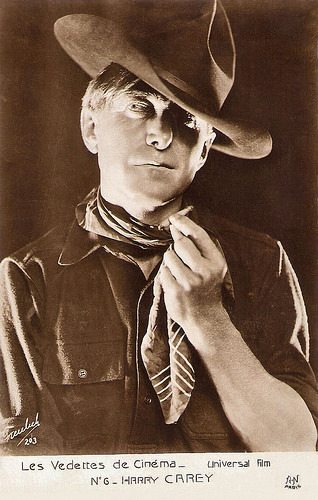
Harry Carey. French postcard in the Les Vedettes de Cinéma series by A.N., Paris, no. 6. Photo: Universal Film / Roman Freulich, no. 203.
American actor and cowboy Harry Carey (1878-1947) was one of silent film's earliest superstars. He was the father of Harry Carey Jr., who was also a prominent actor.
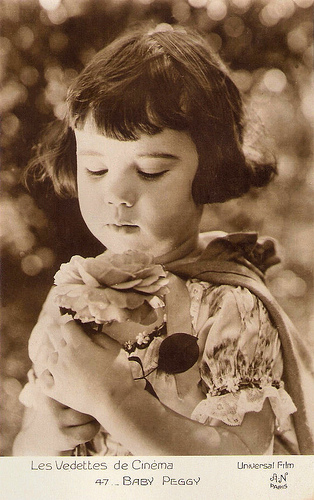
Baby Peggy . French postcard in the Les Vedettes de Cinéma series by A.N., Paris, no. 47. Photo: Universal Film.

Stacia Napierkowska . French postcard in the Les Vedettes de Cinéma series by A.N., Paris, no. 50. Photo: Sobol.
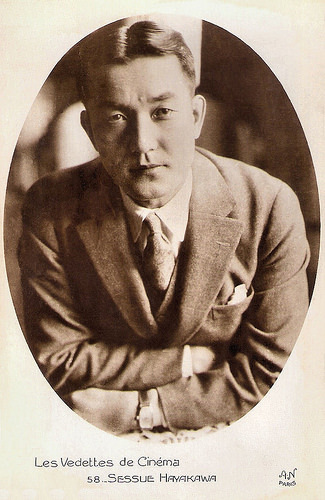
Sessue Hayakawa . French postcard in the Les Vedettes de Cinéma series by A.N., Paris, no. 58.
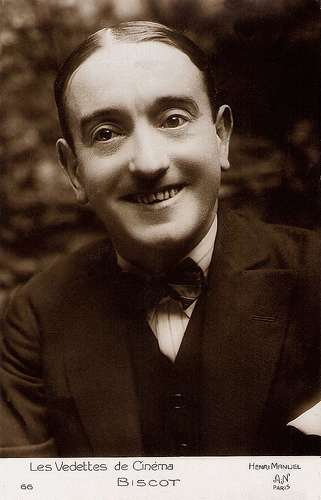
Georges Biscot . French postcard in the Les Vedettes de Cinéma series by A.N., Paris, no. 66. Photo: Henri Manuel.
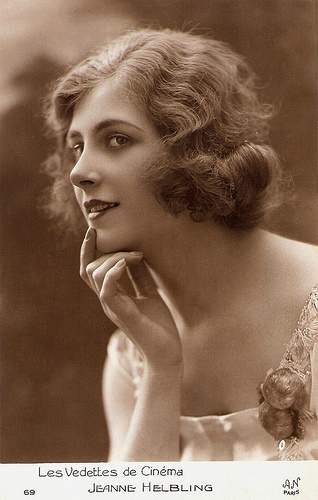
Jeanne Helbling. French postcard in the Les Vedettes de Cinéma series by A.N., Paris, no. 69.
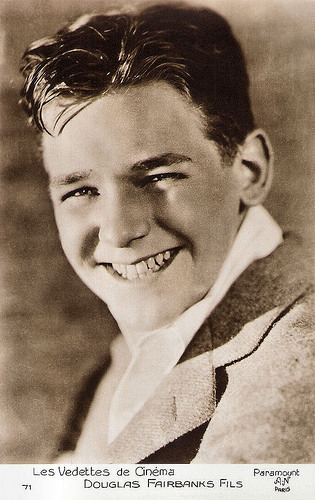
Douglas Fairbanks Jr. French postcard in the Les Vedettes de Cinéma series by A.N. Paris, no. 71. Photo: Paramount.
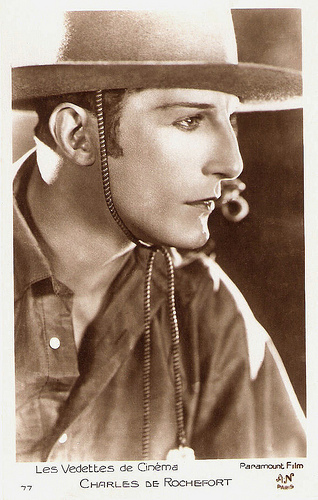
Charles de Rochefort . French postcard in the Les Vedettes de Cinéma series by A.N., Paris, no. 77. Photo: Paramount Film.

Ivan Mozzhukhin . French postcard in the Les Vedettes de Cinéma series by A.N., Paris, no. 89. Photo: Film Albatros.

Maxime Desjardins . French postcard in the Les Vedettes de Cinéma series by A.N., Paris, no. 94. Photo: G.L. Manuel Frères.

Gina Relly . French postcard in the Les Vedettes de Cinéma series by A.N., Paris, no. 98. Photo: Sartony.
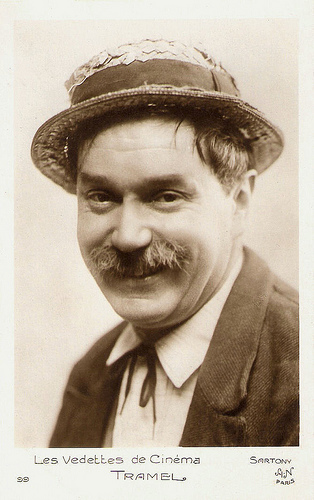
Tramel . French postcard in the Les Vedettes de Cinéma series by Editions A.N., Paris, no. 99. Photo: Sartony.
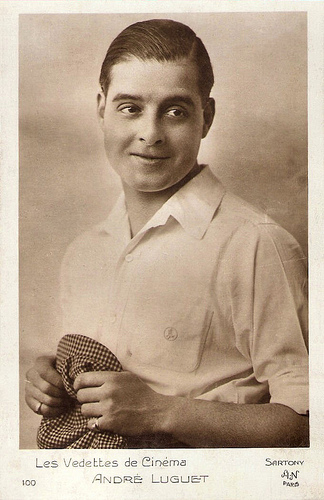
André Luguet . French postcard in the Les Vedettes de Cinéma series by Editions A.N., Paris, no. 100. Photo: Sartony.
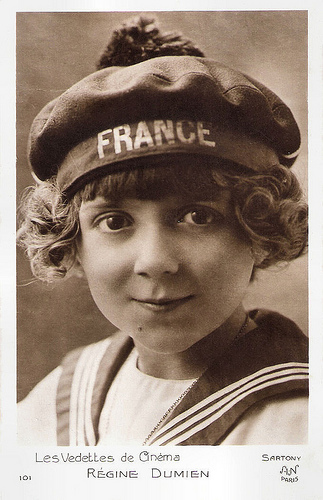
Régine Dumien . French postcard in the Les Vedettes de Cinéma series by Editions A.N., Paris, no. 101. Photo: Sartony.

Dolly Davis . French postcard in the Les Vedettes de Cinéma series by A.N., Paris, no. 112. Photo: G.L. Manuel Freres.
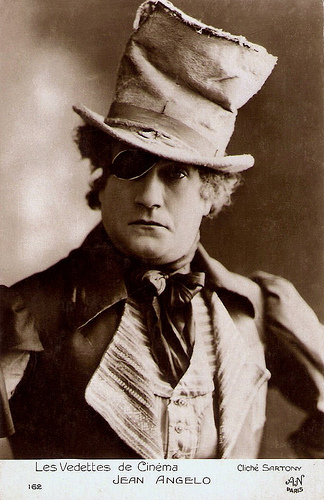
Jean Angelo . French postcard in the Les Vedettes de Cinema series by A.N., Paris, no. 162. Photo: Sartony.
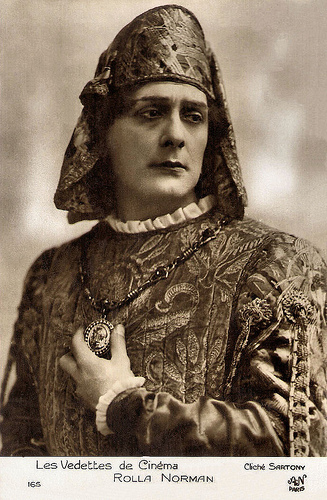
Rolla Norman . French postcard in the Les Vedettes de Cinéma series by A.N., Paris, no. 165. Photo: Sartony.
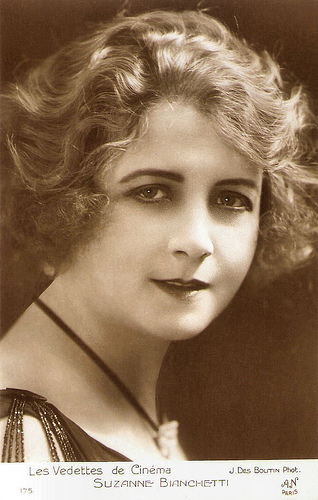
Suzanne Bianchetti . French postcard in the Les Vedettes de Cinéma series by A.N., Paris, no. 175. Photo: J. des Boutin.
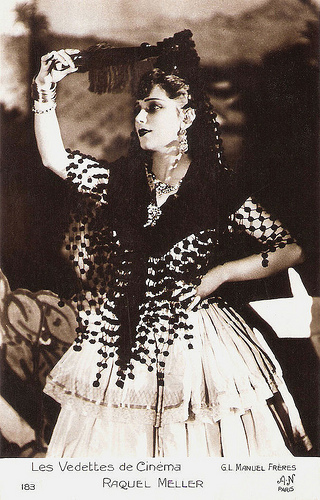
Raquel Meller . French postcard in the Les Vedettes de Cinéma series by A.N., Paris, no. 183. Photo: G.L. Manuel Frères.

Sandra Milowanoff . French postcard in the Les Vedettes de Cinéma series by A.N., Paris, no. 185. Photo: G.L. Manuel Frères.
Source: Wikipedia (French) and Ross Postcards.

Harry Carey. French postcard in the Les Vedettes de Cinéma series by A.N., Paris, no. 6. Photo: Universal Film / Roman Freulich, no. 203.
American actor and cowboy Harry Carey (1878-1947) was one of silent film's earliest superstars. He was the father of Harry Carey Jr., who was also a prominent actor.

Baby Peggy . French postcard in the Les Vedettes de Cinéma series by A.N., Paris, no. 47. Photo: Universal Film.

Stacia Napierkowska . French postcard in the Les Vedettes de Cinéma series by A.N., Paris, no. 50. Photo: Sobol.

Sessue Hayakawa . French postcard in the Les Vedettes de Cinéma series by A.N., Paris, no. 58.

Georges Biscot . French postcard in the Les Vedettes de Cinéma series by A.N., Paris, no. 66. Photo: Henri Manuel.

Jeanne Helbling. French postcard in the Les Vedettes de Cinéma series by A.N., Paris, no. 69.

Douglas Fairbanks Jr. French postcard in the Les Vedettes de Cinéma series by A.N. Paris, no. 71. Photo: Paramount.

Charles de Rochefort . French postcard in the Les Vedettes de Cinéma series by A.N., Paris, no. 77. Photo: Paramount Film.

Ivan Mozzhukhin . French postcard in the Les Vedettes de Cinéma series by A.N., Paris, no. 89. Photo: Film Albatros.

Maxime Desjardins . French postcard in the Les Vedettes de Cinéma series by A.N., Paris, no. 94. Photo: G.L. Manuel Frères.

Gina Relly . French postcard in the Les Vedettes de Cinéma series by A.N., Paris, no. 98. Photo: Sartony.

Tramel . French postcard in the Les Vedettes de Cinéma series by Editions A.N., Paris, no. 99. Photo: Sartony.

André Luguet . French postcard in the Les Vedettes de Cinéma series by Editions A.N., Paris, no. 100. Photo: Sartony.

Régine Dumien . French postcard in the Les Vedettes de Cinéma series by Editions A.N., Paris, no. 101. Photo: Sartony.

Dolly Davis . French postcard in the Les Vedettes de Cinéma series by A.N., Paris, no. 112. Photo: G.L. Manuel Freres.

Jean Angelo . French postcard in the Les Vedettes de Cinema series by A.N., Paris, no. 162. Photo: Sartony.

Rolla Norman . French postcard in the Les Vedettes de Cinéma series by A.N., Paris, no. 165. Photo: Sartony.

Suzanne Bianchetti . French postcard in the Les Vedettes de Cinéma series by A.N., Paris, no. 175. Photo: J. des Boutin.

Raquel Meller . French postcard in the Les Vedettes de Cinéma series by A.N., Paris, no. 183. Photo: G.L. Manuel Frères.

Sandra Milowanoff . French postcard in the Les Vedettes de Cinéma series by A.N., Paris, no. 185. Photo: G.L. Manuel Frères.
Source: Wikipedia (French) and Ross Postcards.
Published on October 27, 2017 22:00
Paul van Yperen's Blog
- Paul van Yperen's profile
- 13 followers
Paul van Yperen isn't a Goodreads Author
(yet),
but they
do have a blog,
so here are some recent posts imported from
their feed.



